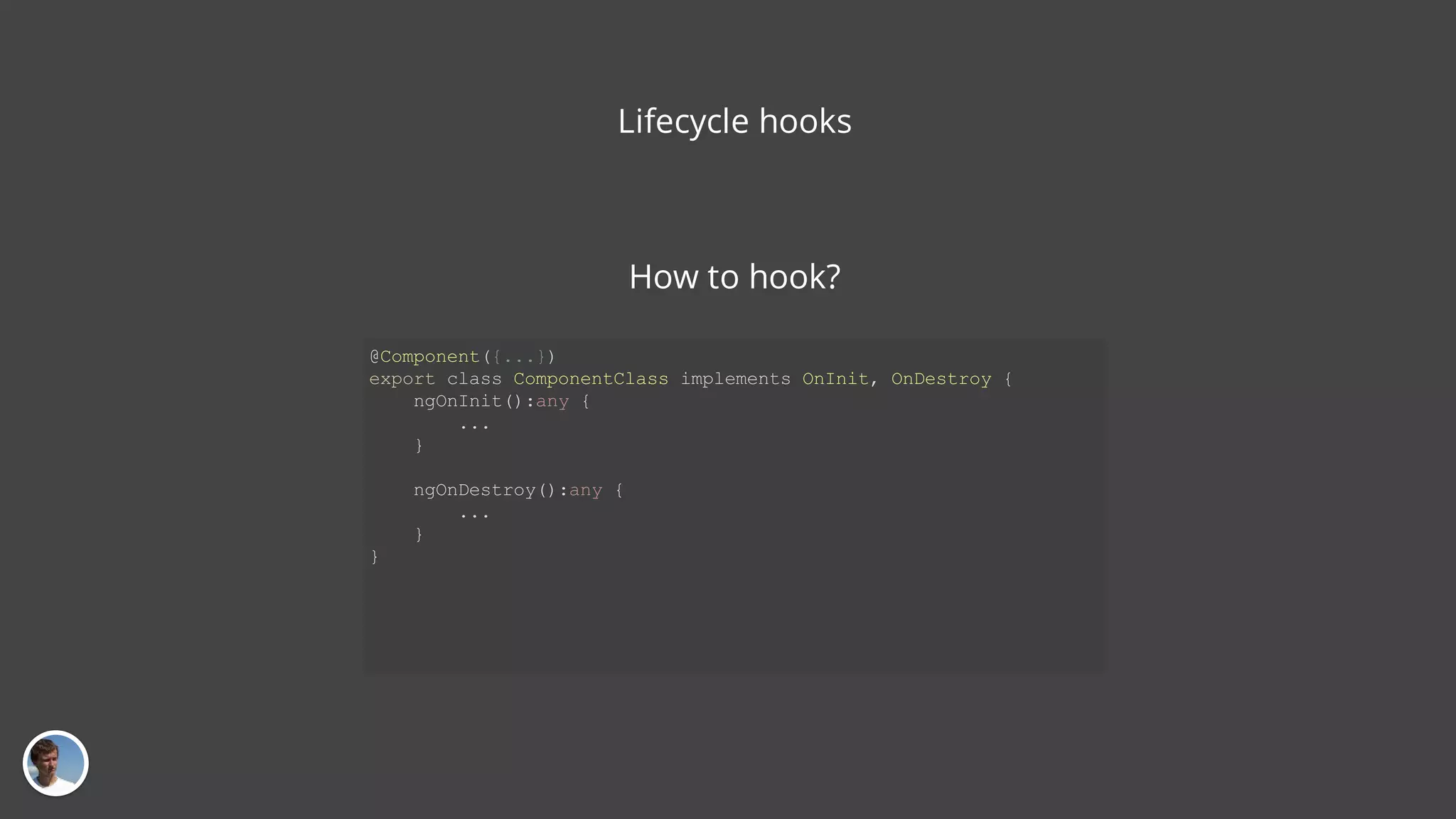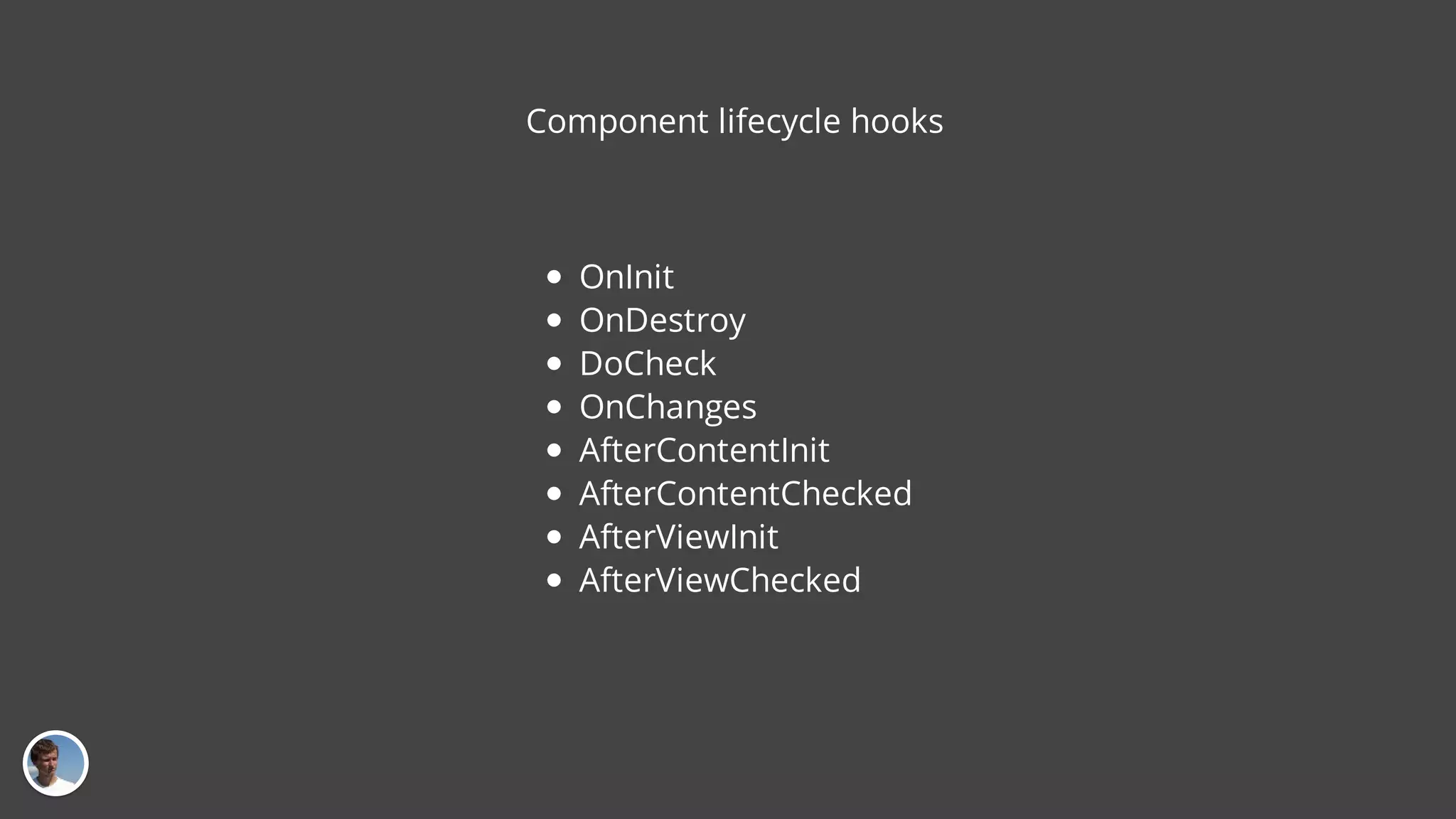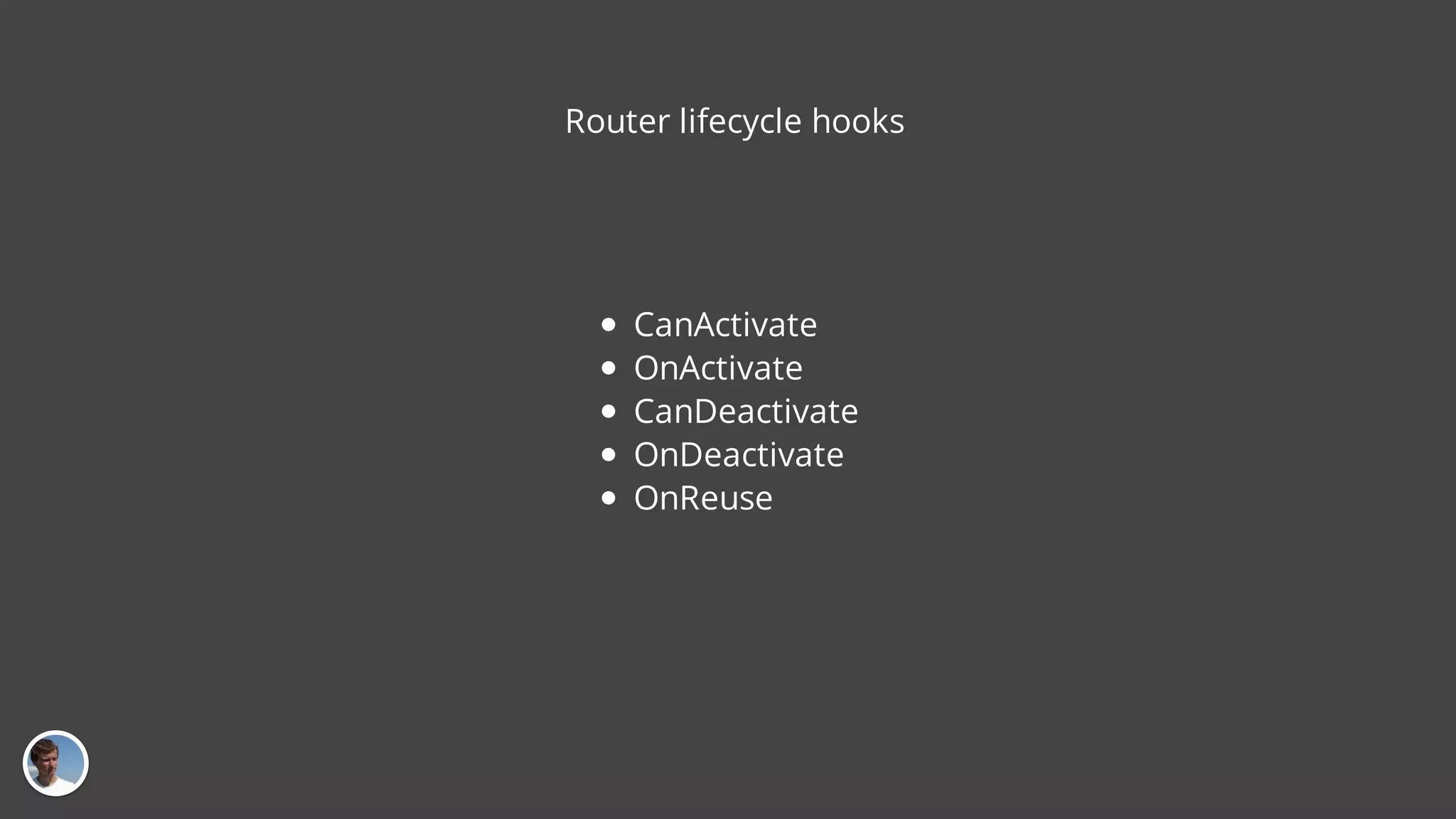This document provides an overview of Angular 2, including: - Angular 2 is a rewrite of AngularJS and introduces many breaking changes. - It uses Typescript as its language and compiles to plain JavaScript. - Key concepts include components, templates, directives, dependency injection, and services. - Components define views using templates, styles, and class logic. They can communicate via inputs and outputs. - Directives add behavior to the existing DOM using selectors like elements, attributes, or classes.
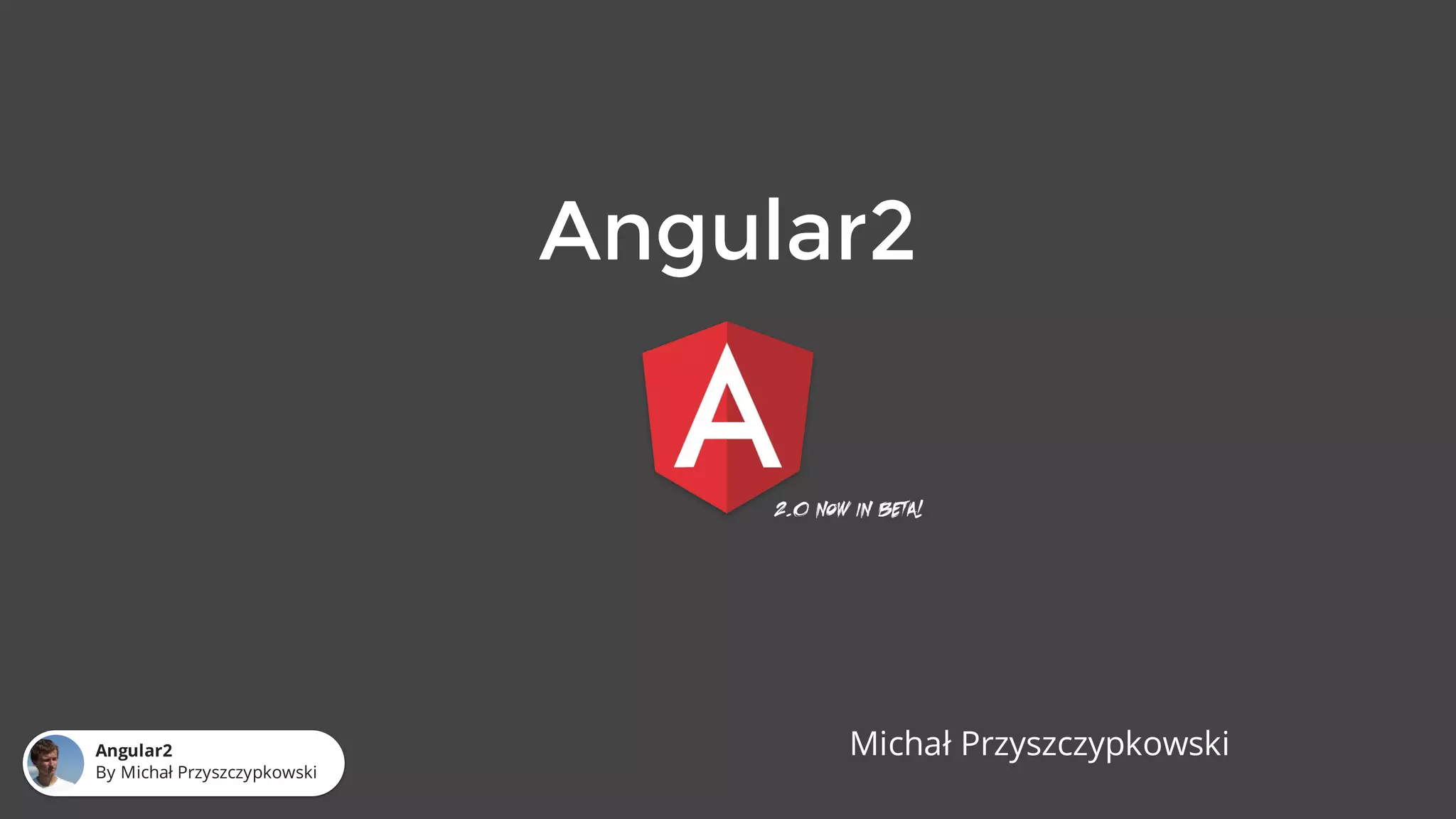
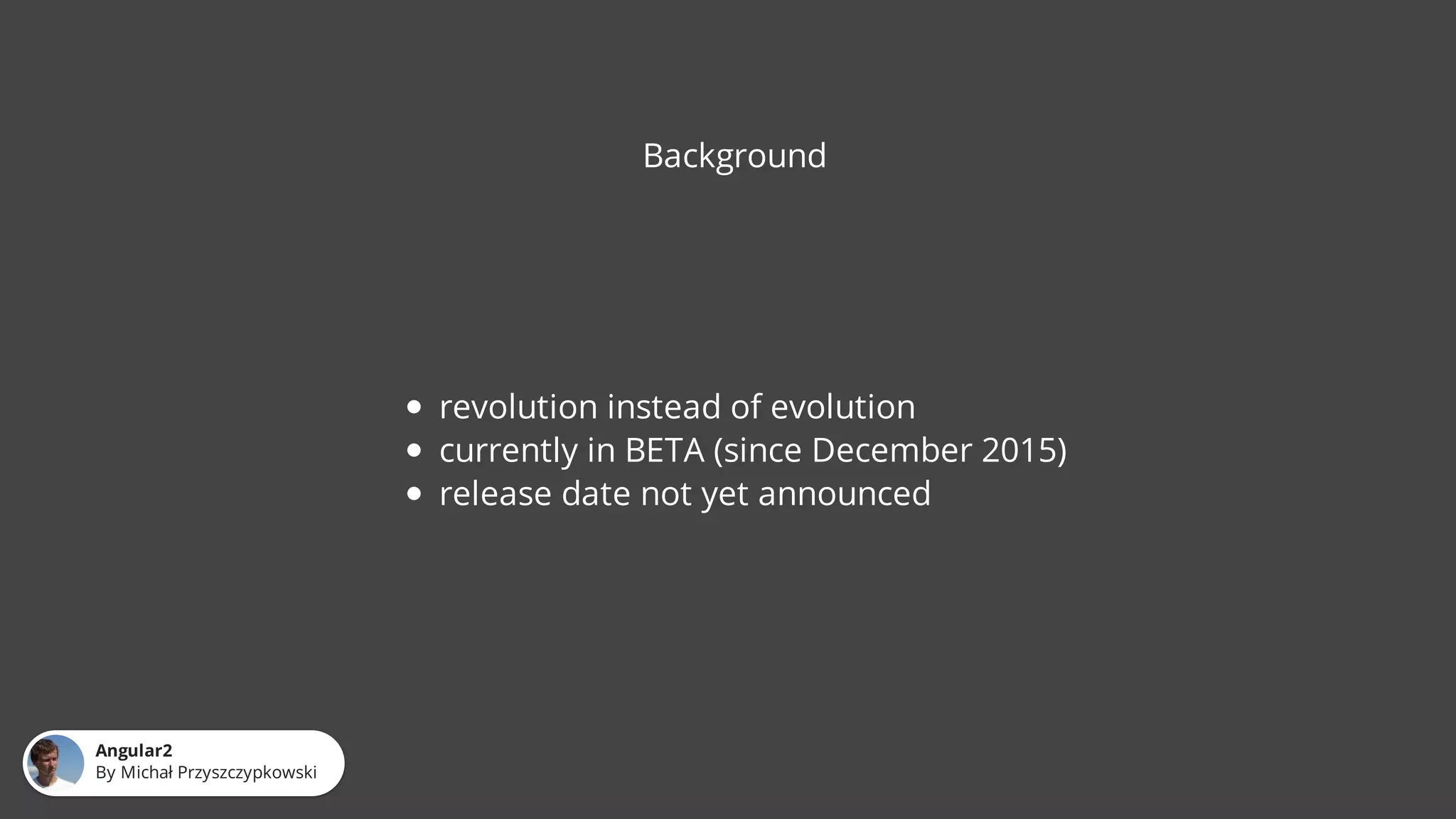
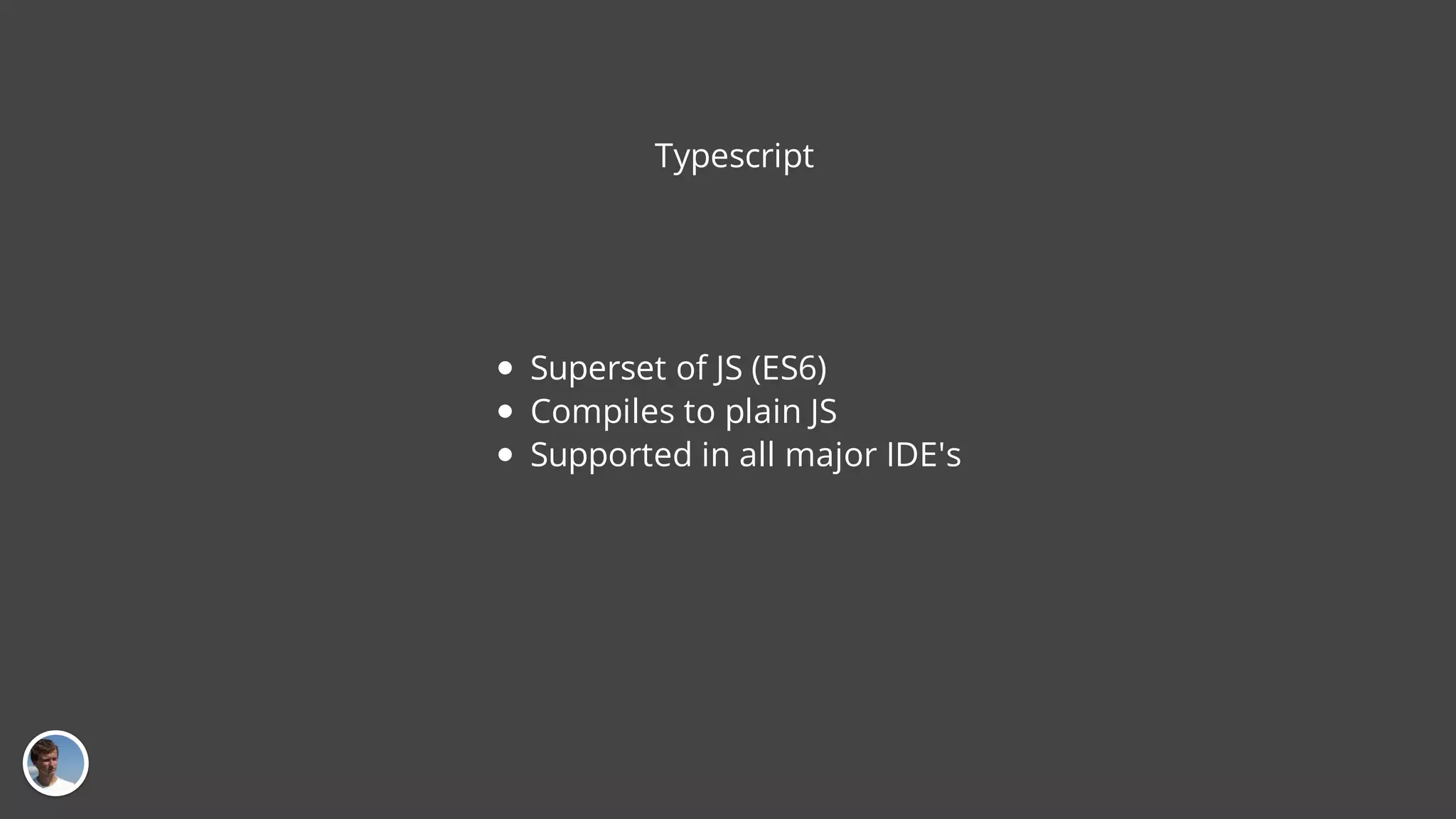
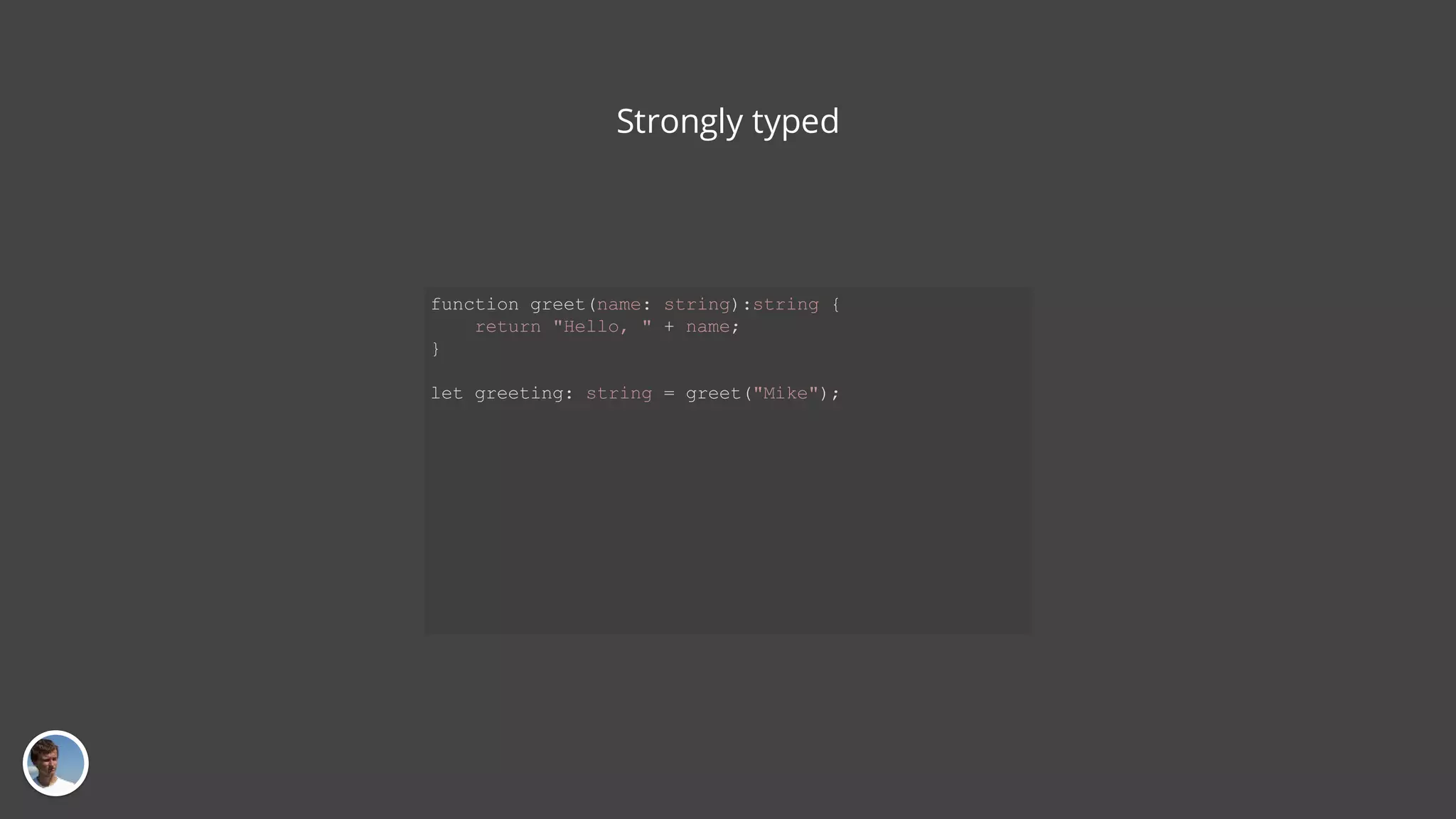
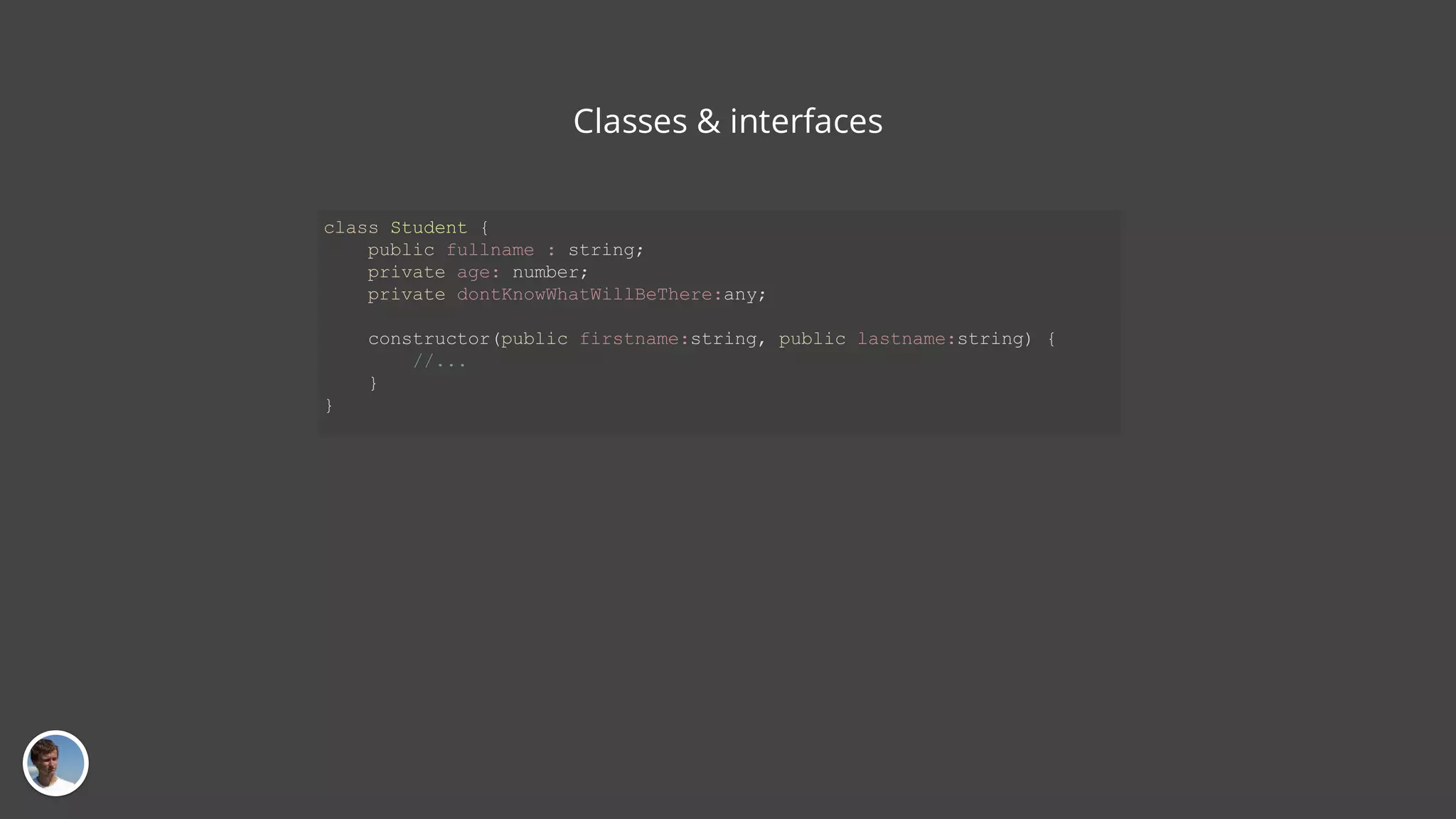
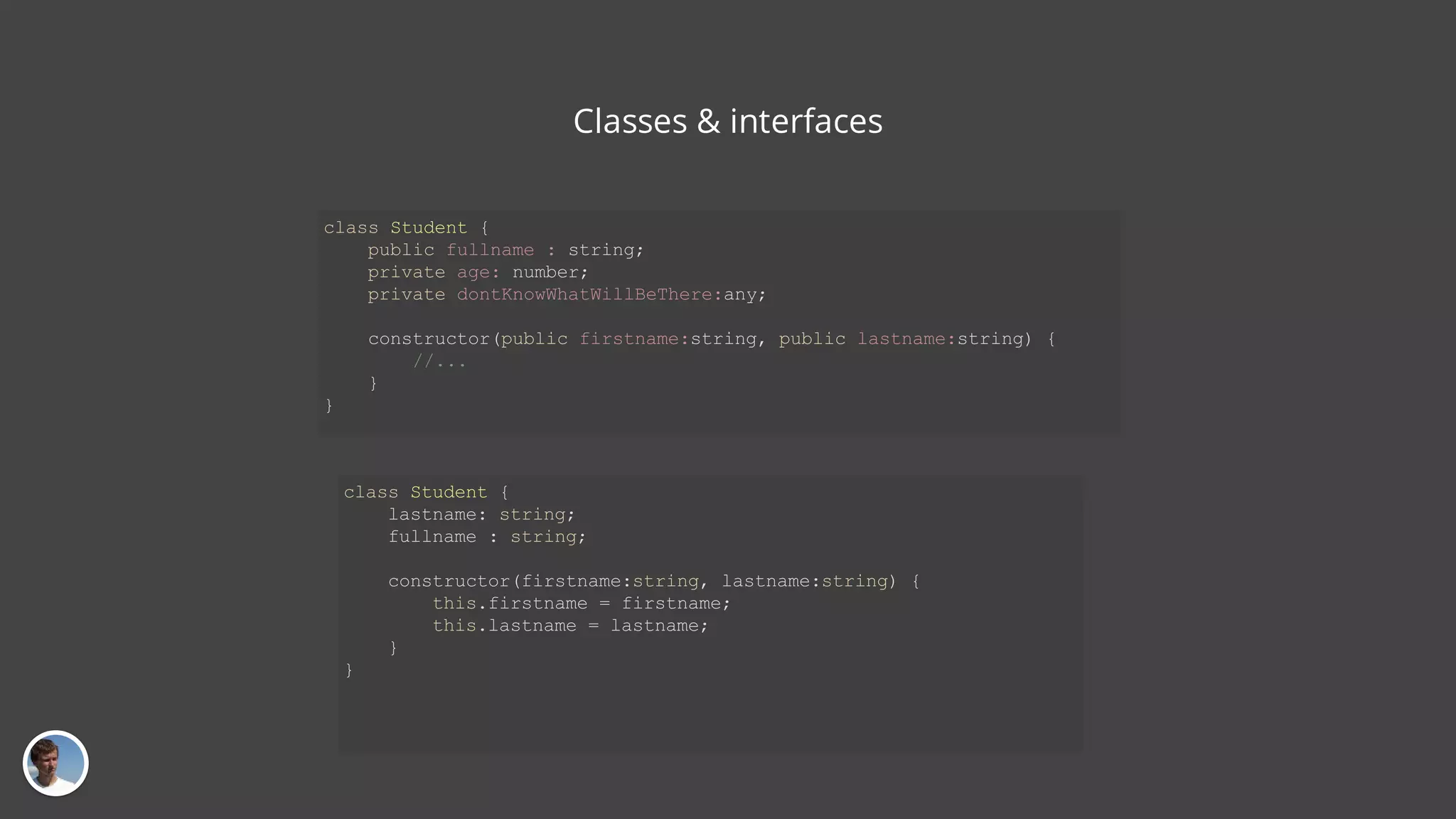
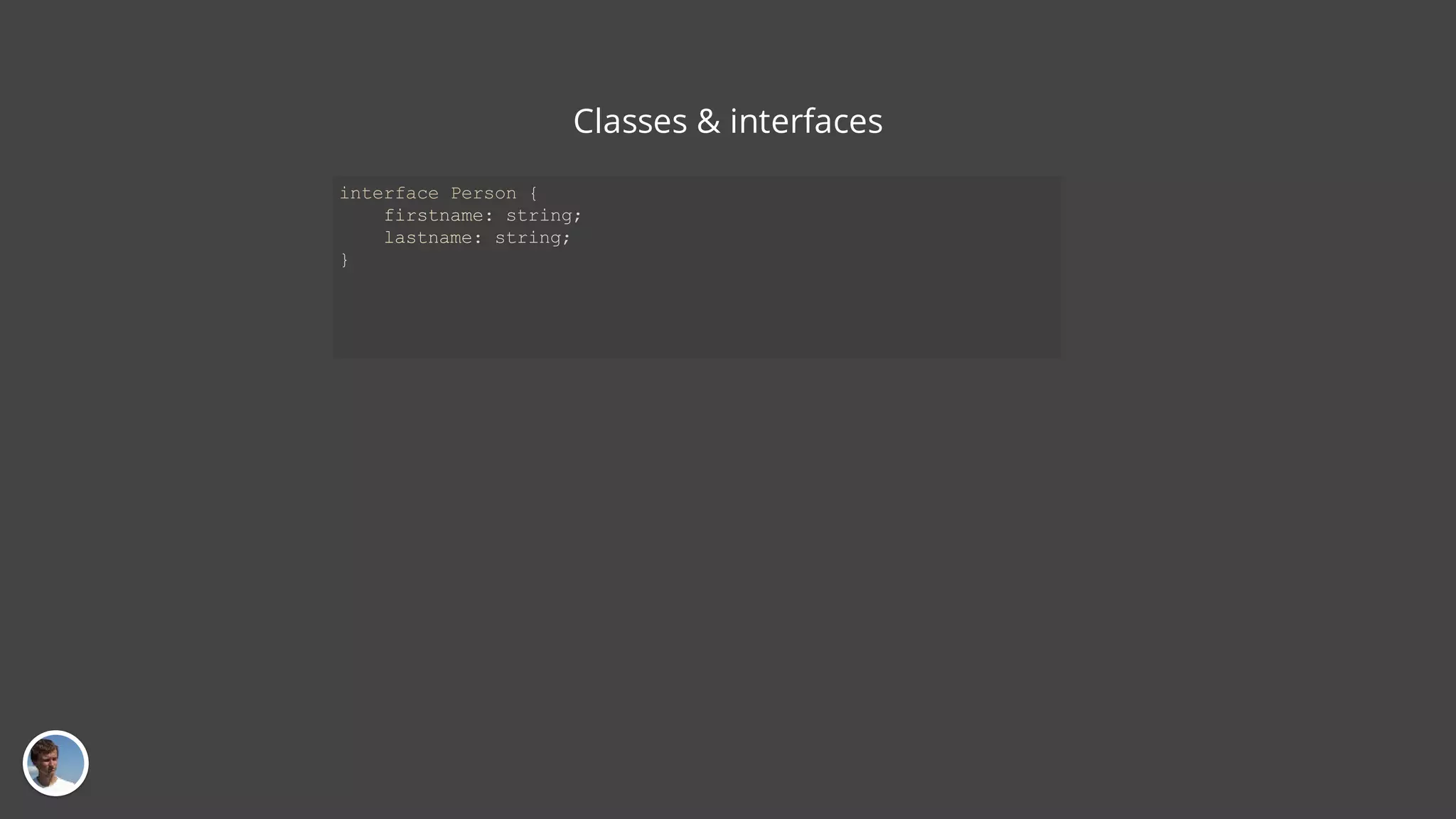
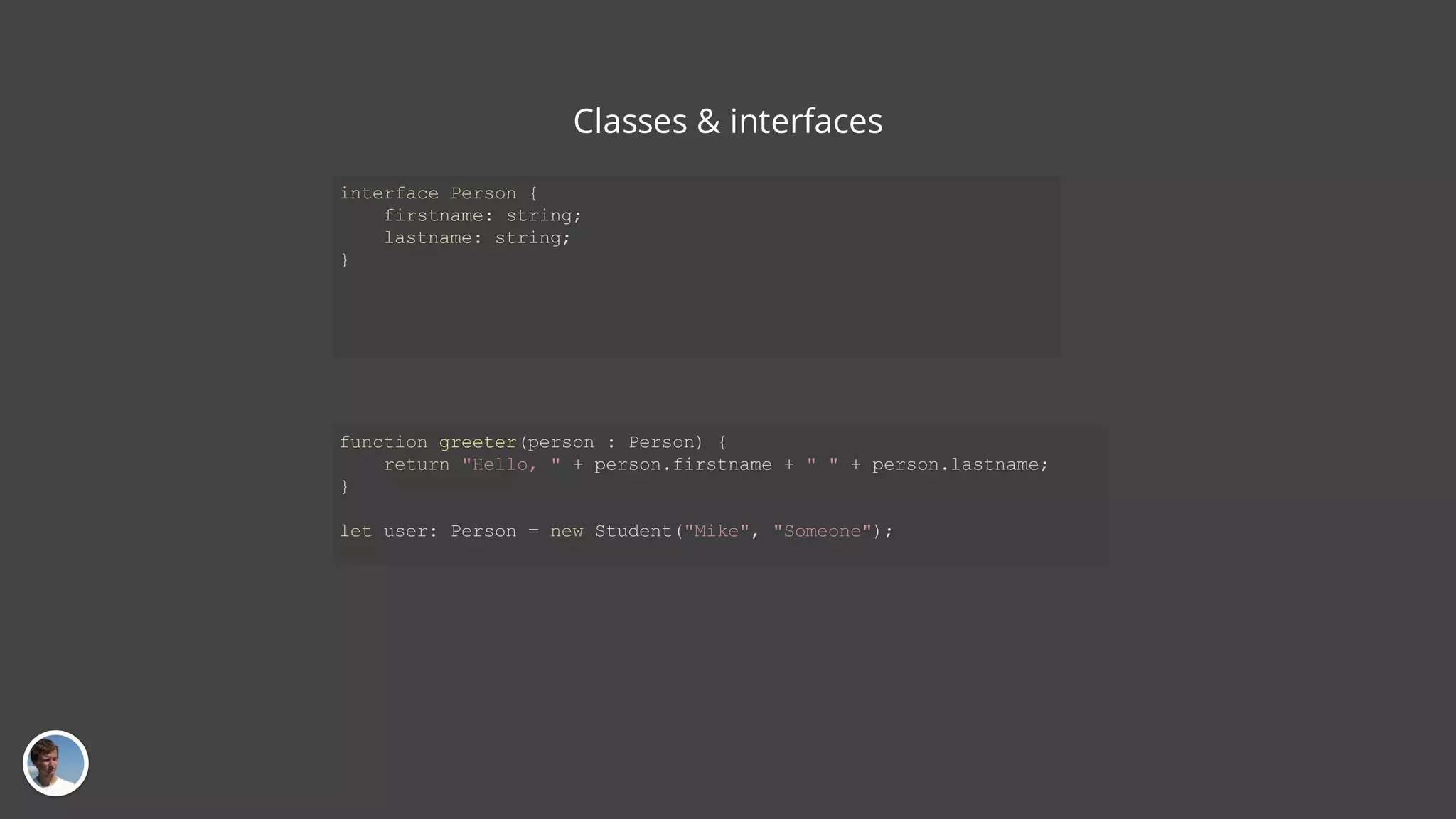
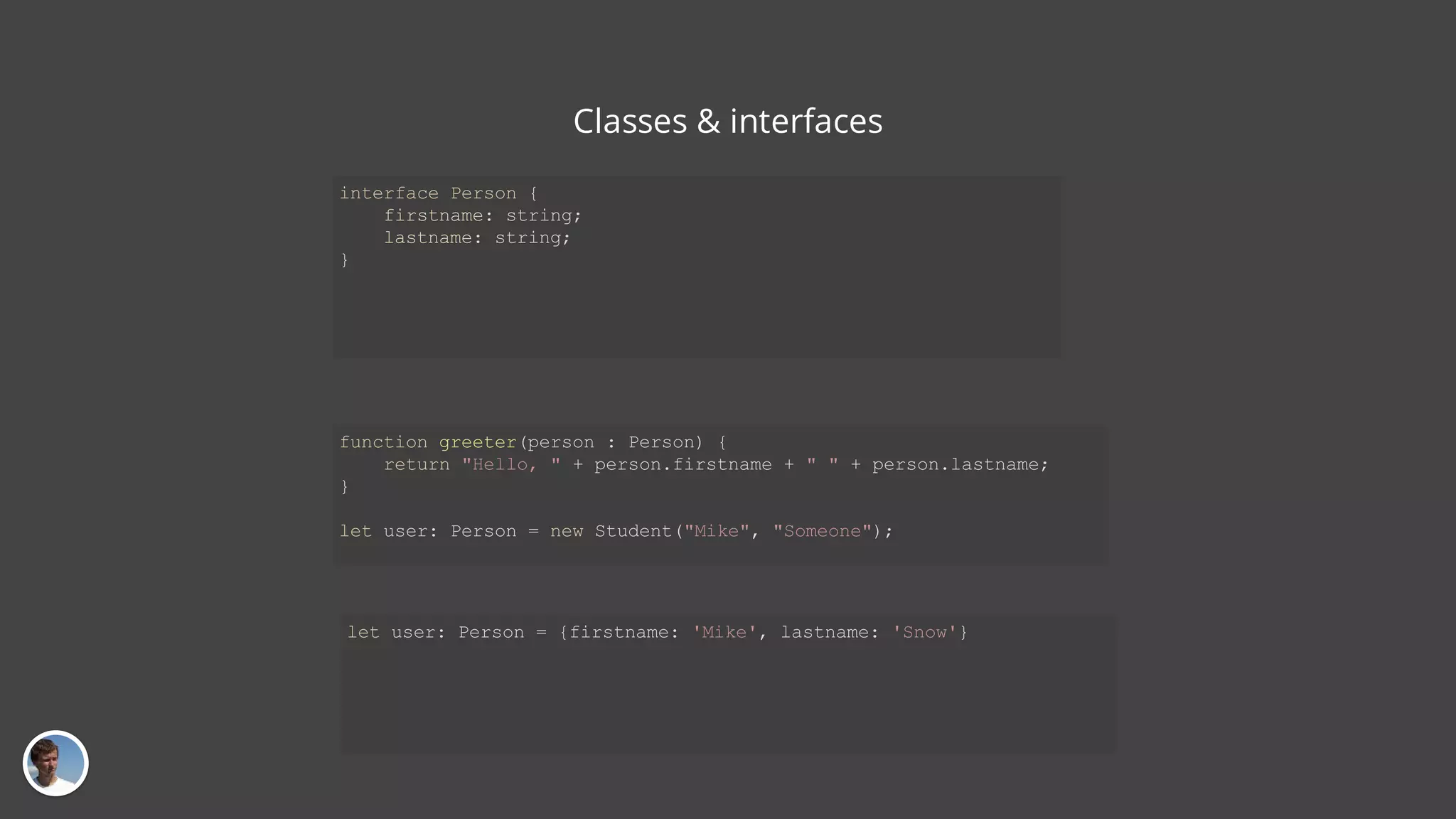
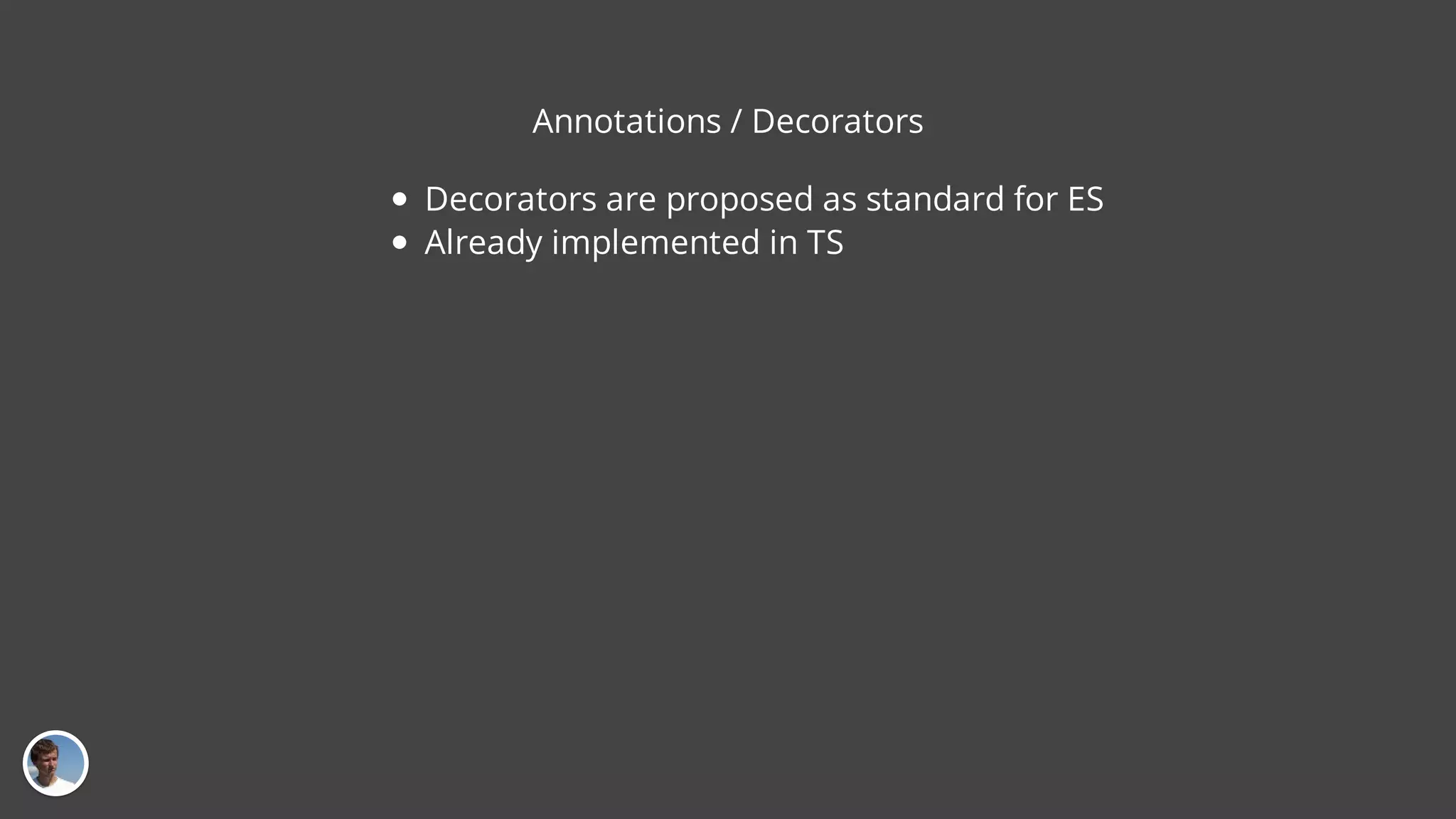
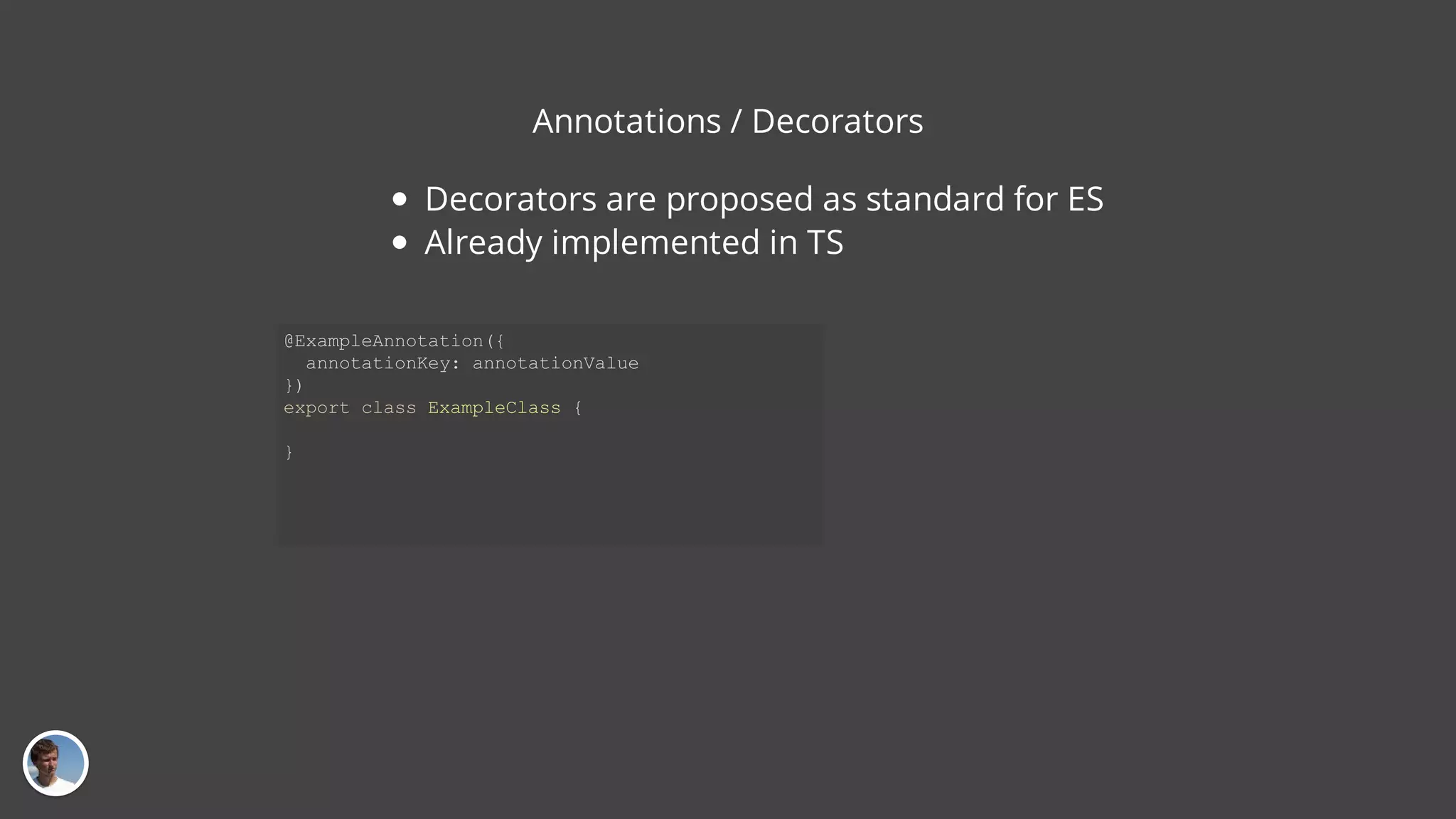
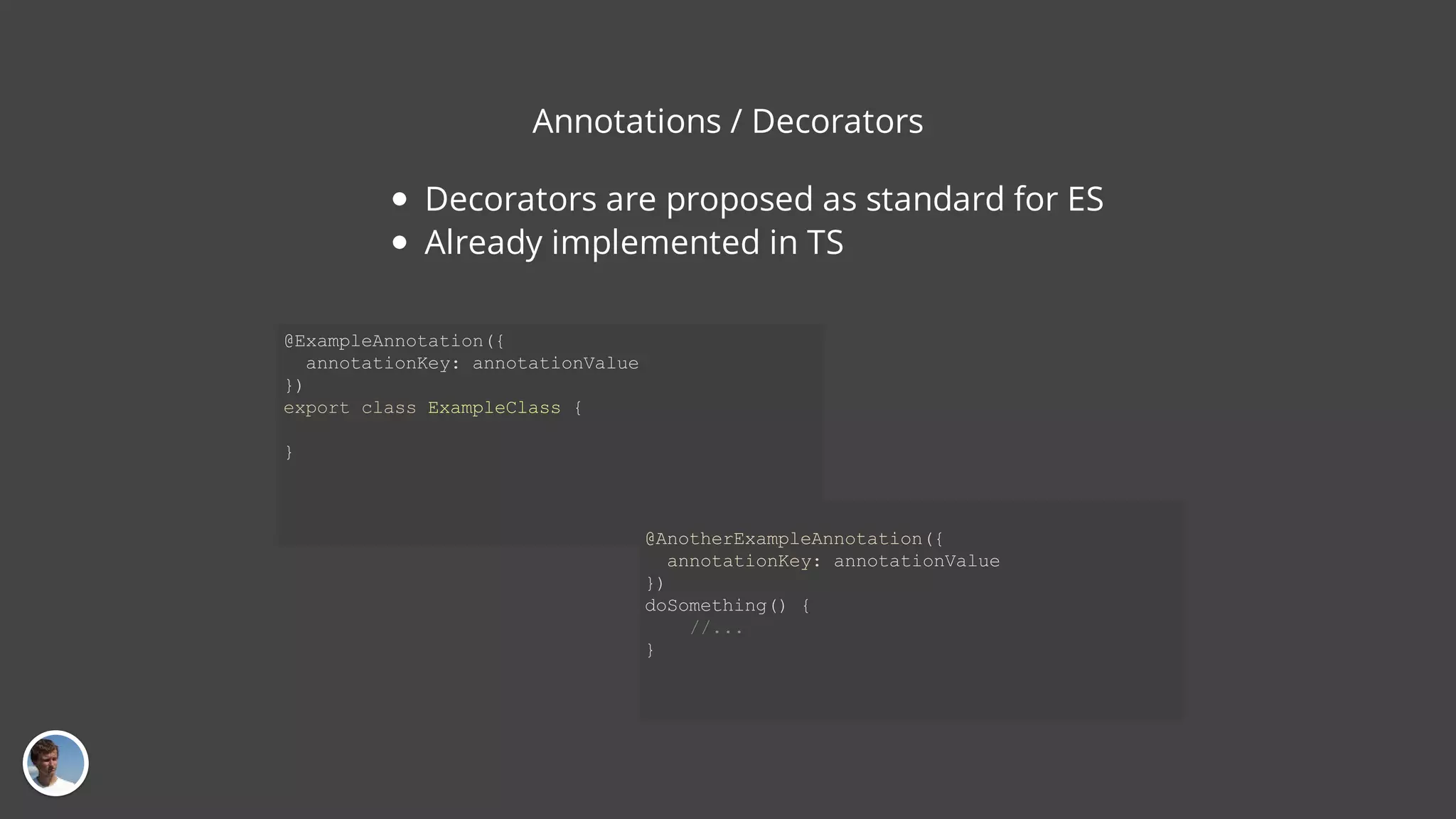
![Modules export interface Person { name: string; } export class PeopleService { getPeople(): People[] { return [{name: 'Mike'}]; } } export const value:string = 'Something';](https://image.slidesharecdn.com/angular2-160212151852/75/An-introduction-to-Angular2-13-2048.jpg)
![Modules import * as library from "./module"; import { Person, PeopleService } from "./module"; console.log(library.value); let peopleSrv = new PeopleService(); let people: Person[] = peopleSrv.getPeople(); export interface Person { name: string; } export class PeopleService { getPeople(): People[] { return [{name: 'Mike'}]; } } export const value:string = 'Something';](https://image.slidesharecdn.com/angular2-160212151852/75/An-introduction-to-Angular2-14-2048.jpg)
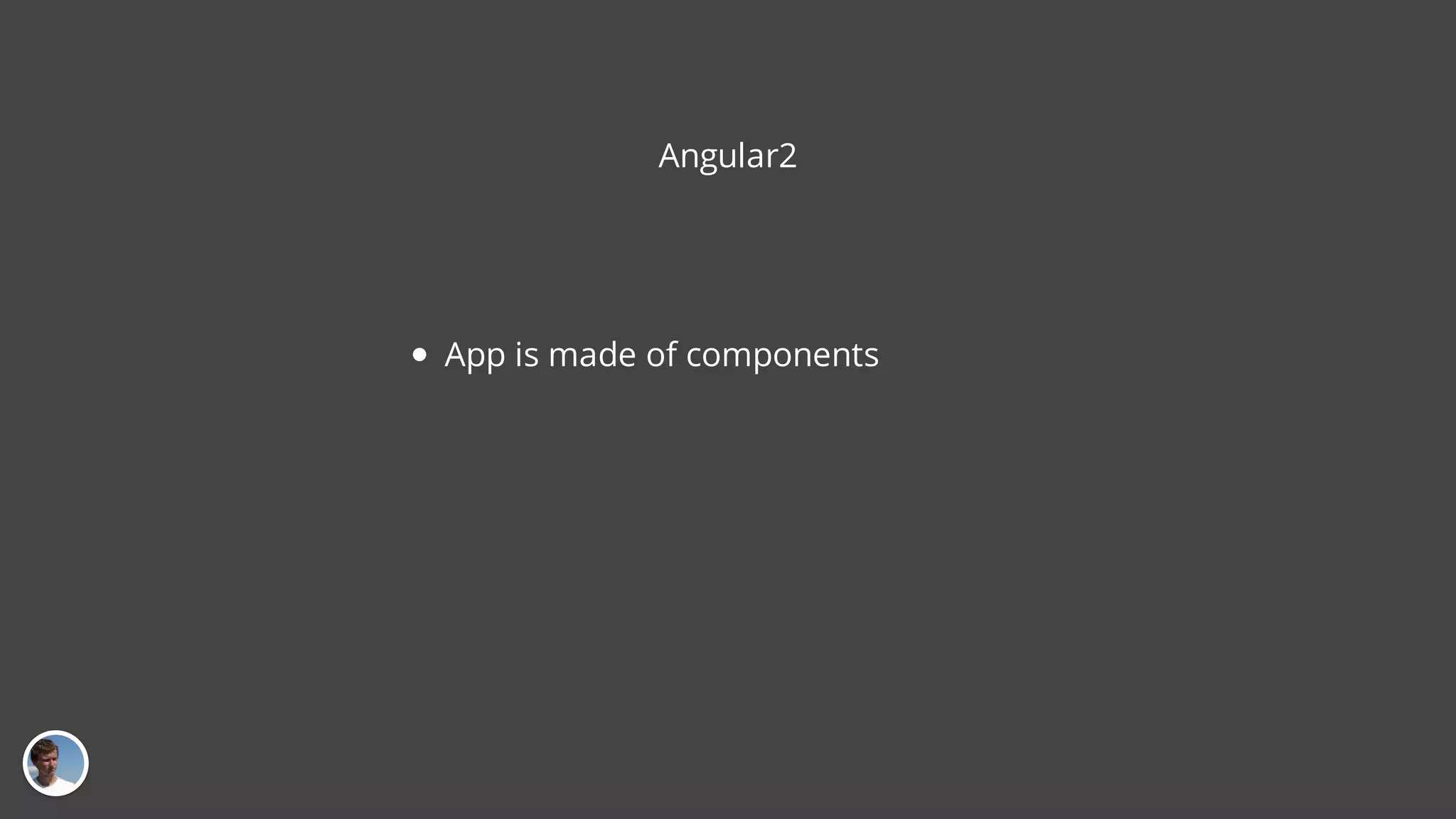
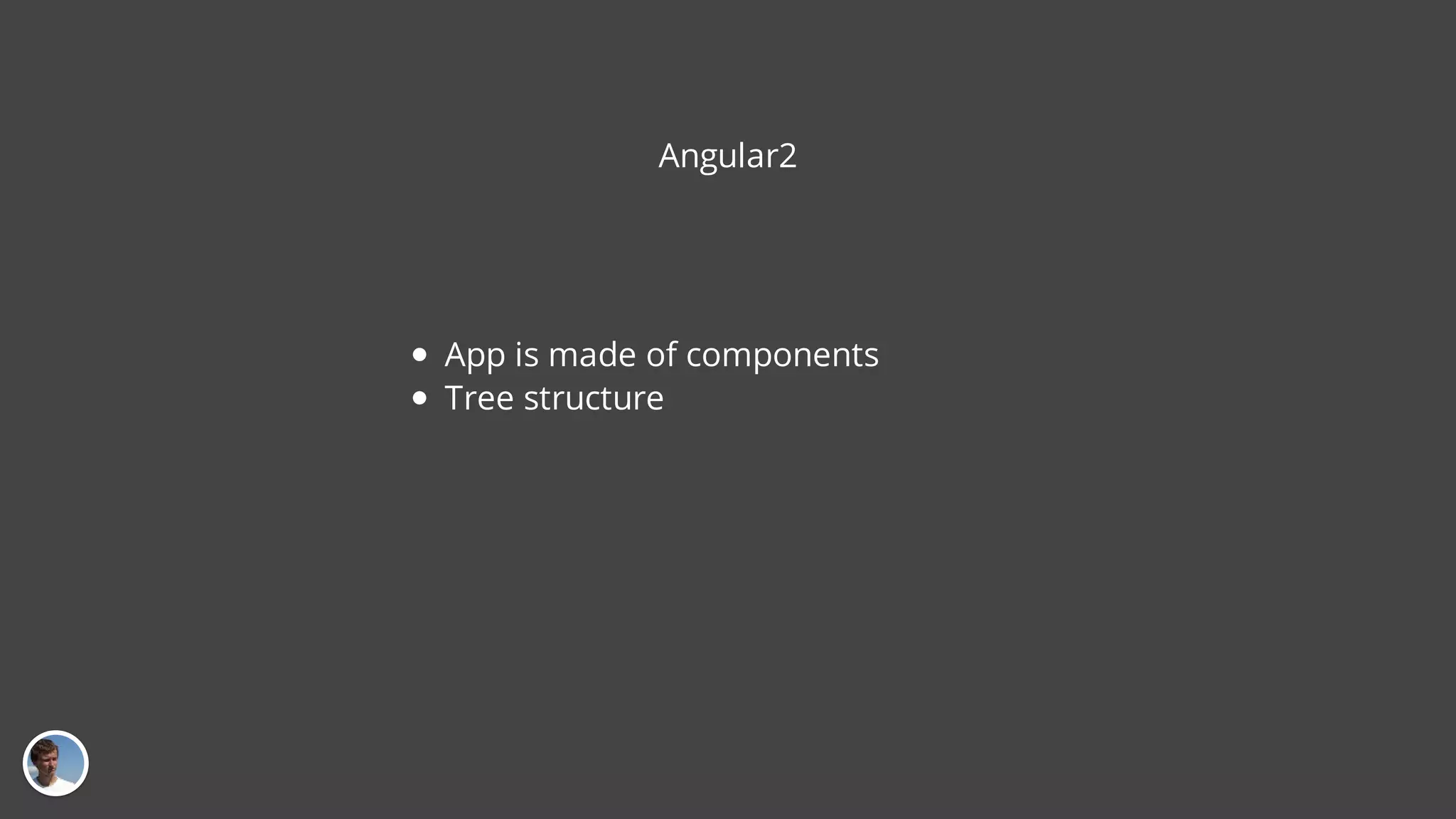
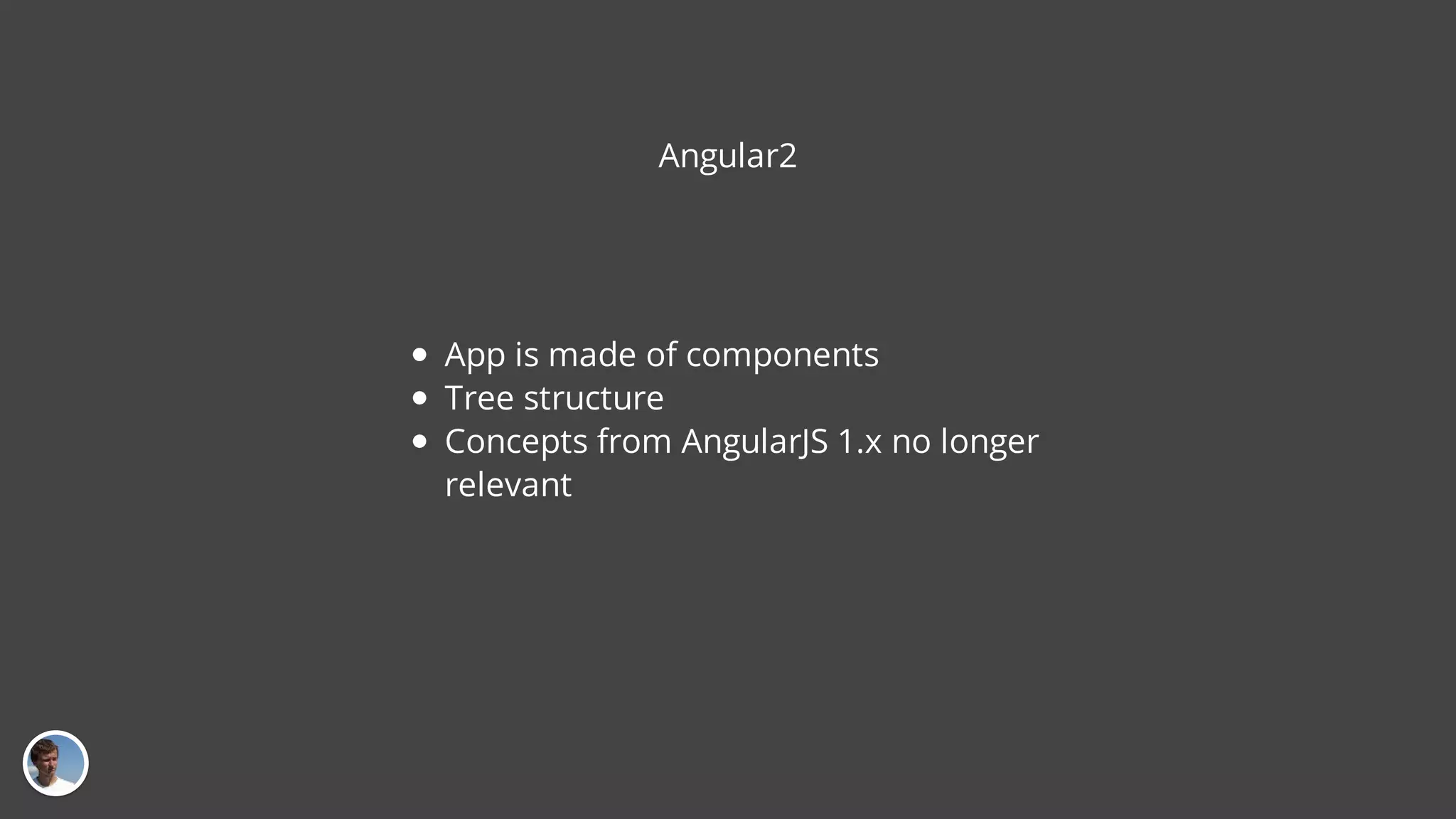
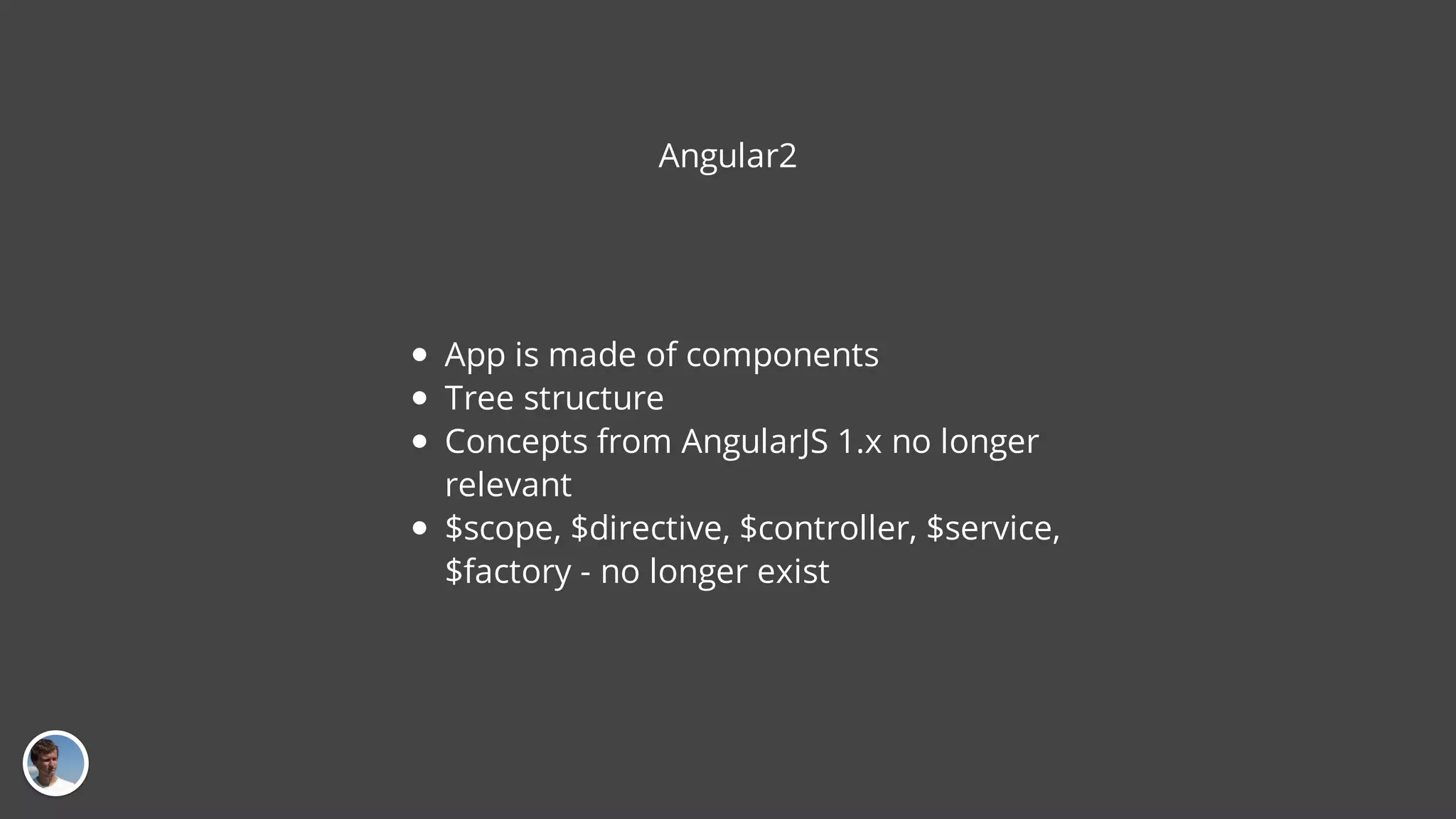
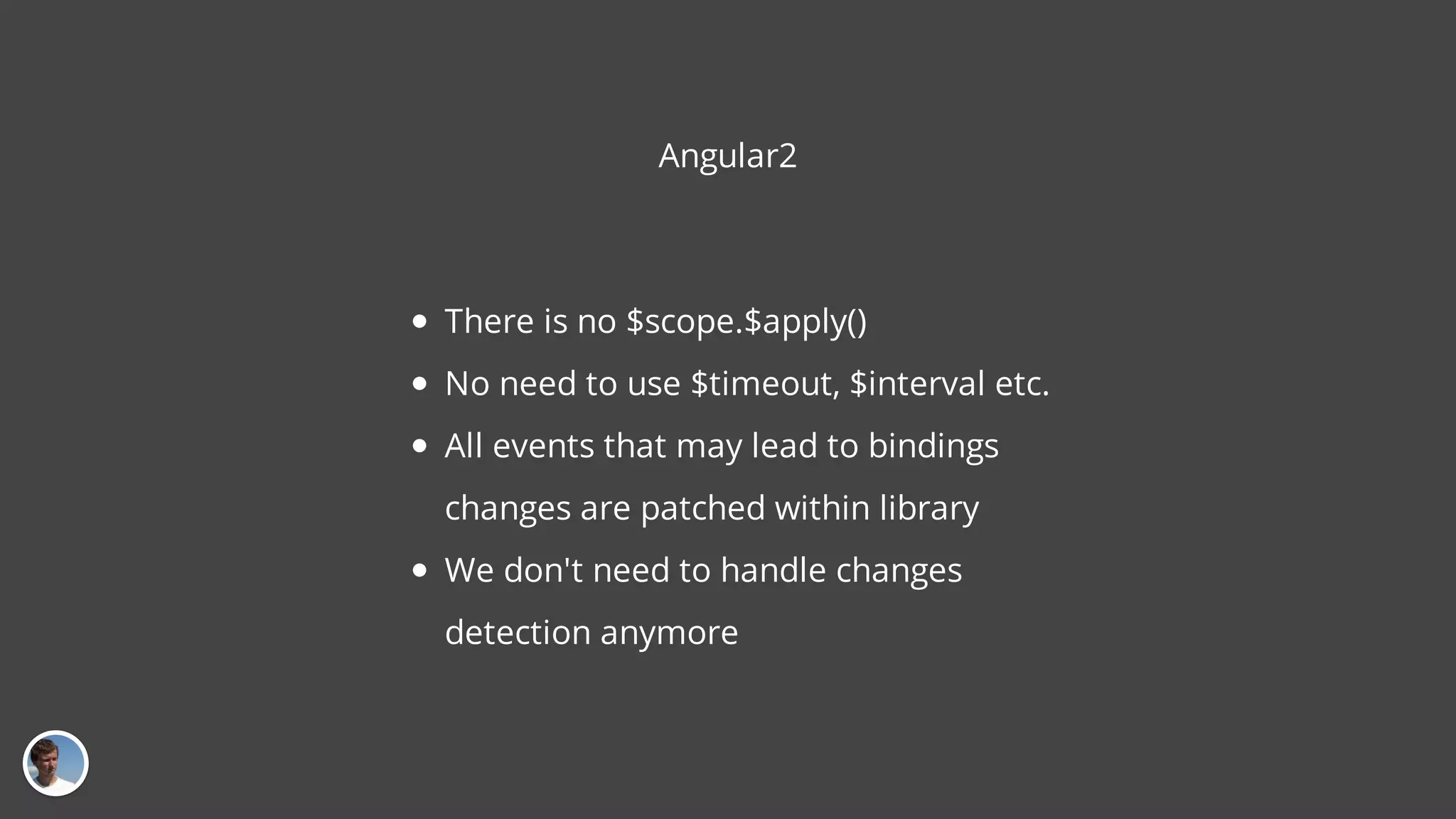
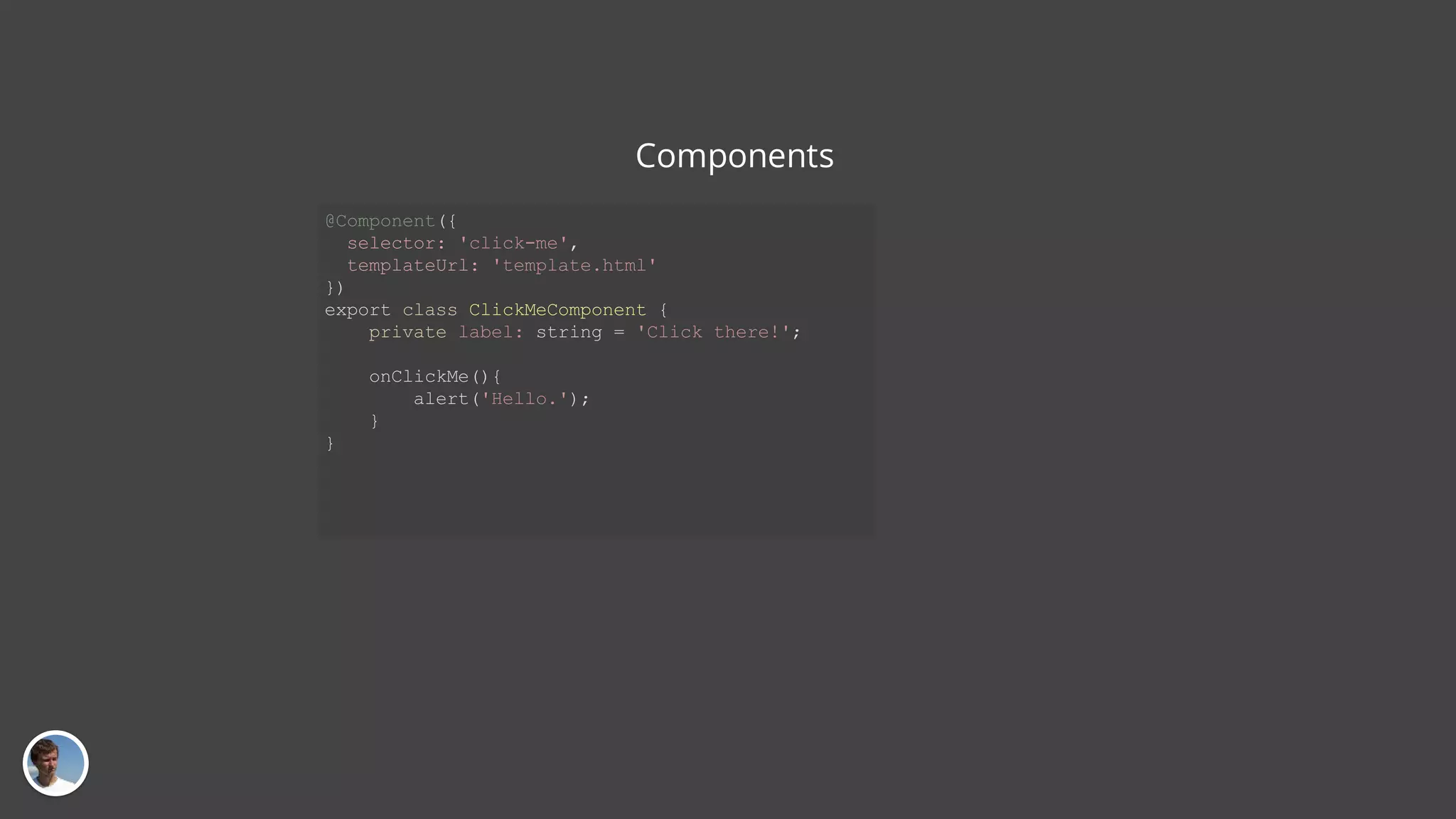
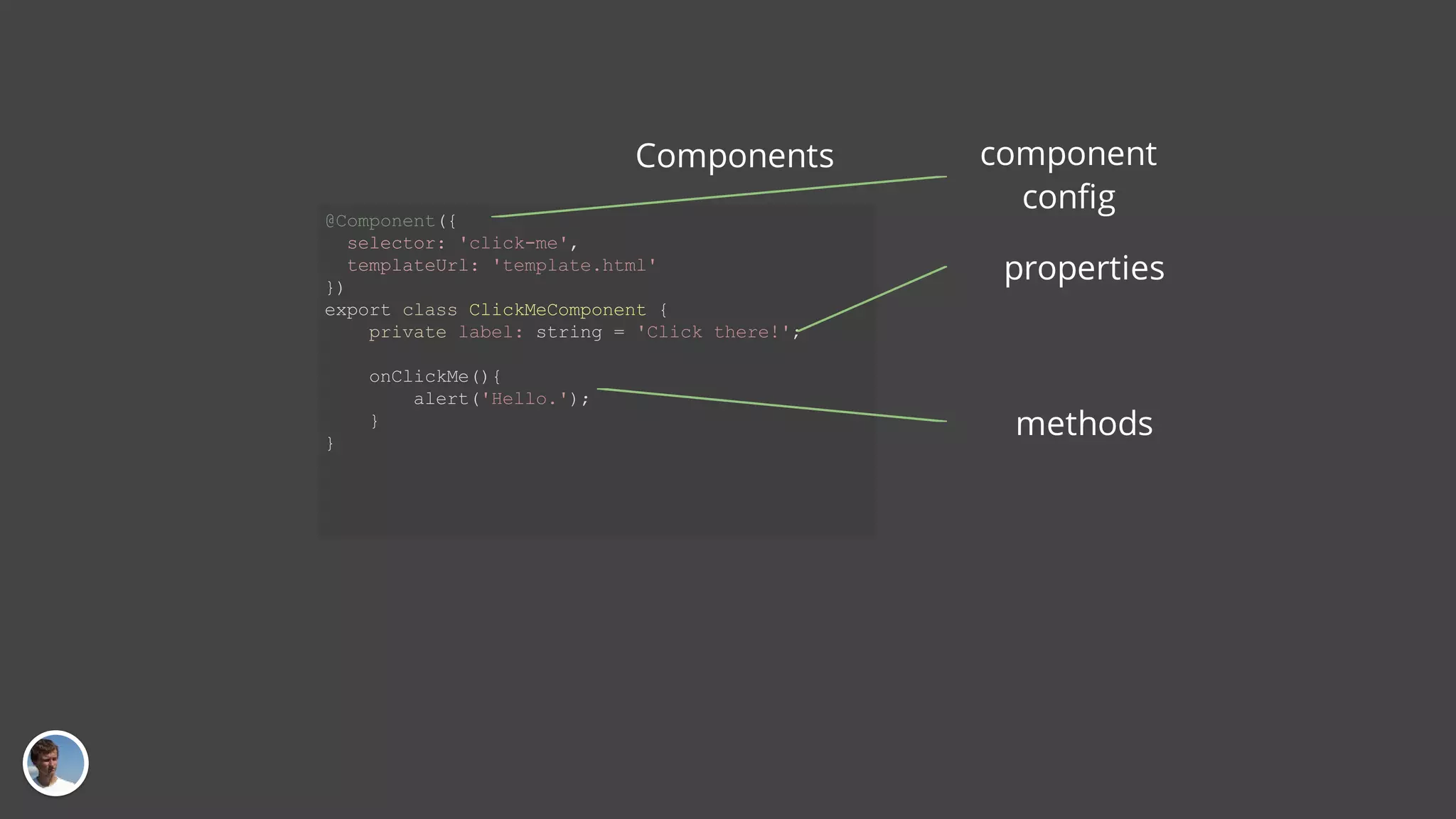
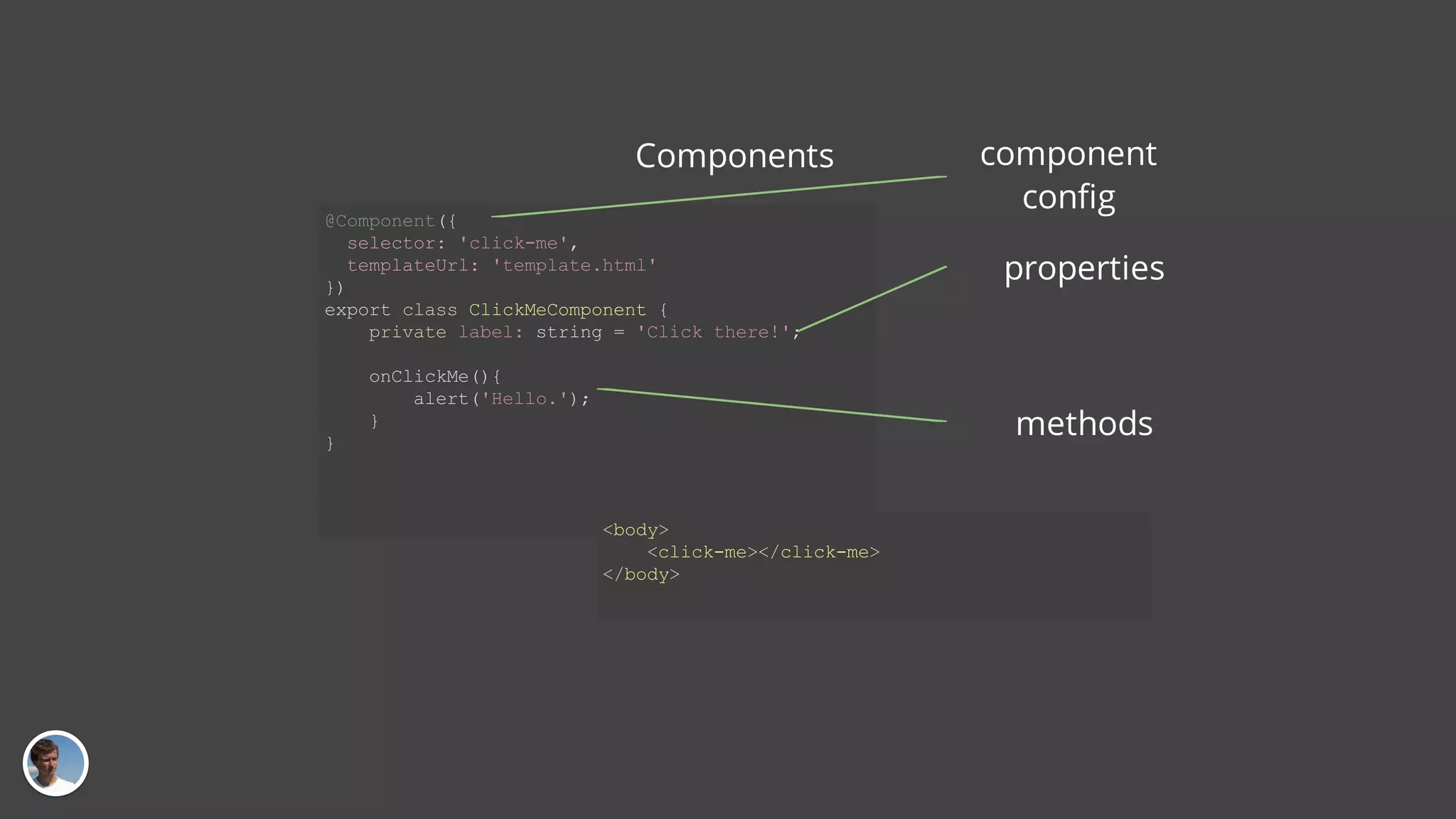
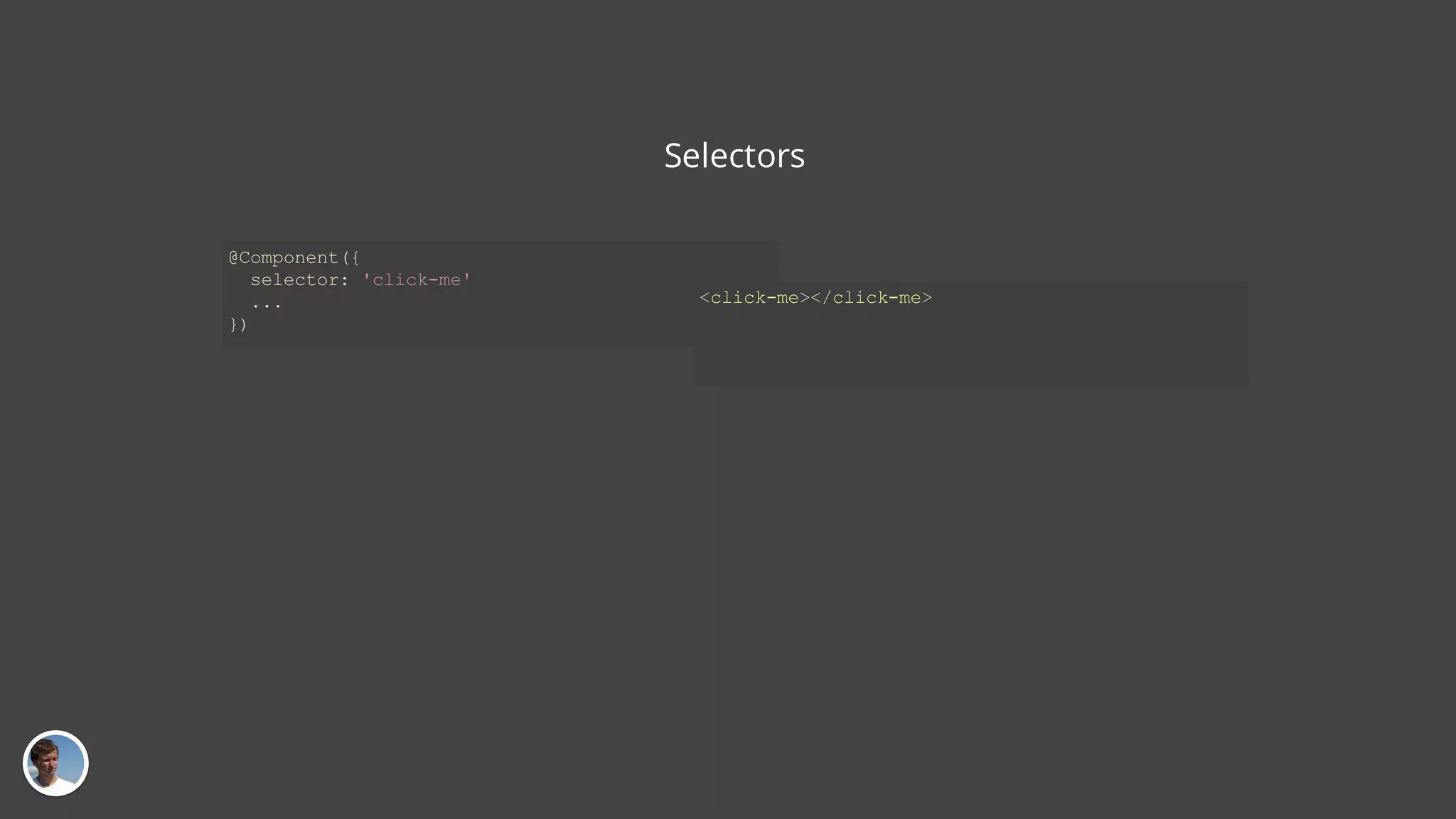
![Selectors @Component({ selector: 'click-me' ... }) <click-me></click-me> @Component({ selector: '[click-me]' ... }) <div click-me=""></div>](https://image.slidesharecdn.com/angular2-160212151852/75/An-introduction-to-Angular2-24-2048.jpg)
![Inputs @Component({ selector: 'click-me', templateUrl: 'template.html', inputs: ['message'] }) export class ClickMeComponent { private message: string; onClickMe(){ alert(this.message); } }](https://image.slidesharecdn.com/angular2-160212151852/75/An-introduction-to-Angular2-25-2048.jpg)
![Inputs @Component({ selector: 'click-me', templateUrl: 'template.html', inputs: ['message'] }) export class ClickMeComponent { private message: string; onClickMe(){ alert(this.message); } } <click-me message="Peekaboo"></click-me>](https://image.slidesharecdn.com/angular2-160212151852/75/An-introduction-to-Angular2-26-2048.jpg)
![Outputs @Component({ selector: 'click-me', templateUrl: 'template.html', outputs: ['onClicked'] }) export class ClickMeComponent { private onClicked: EventEmitter<string> = new EventEmitter<string>(); onClickMe(){ this.onClicked.emit("Hello"); } }](https://image.slidesharecdn.com/angular2-160212151852/75/An-introduction-to-Angular2-27-2048.jpg)
![Outputs @Component({ selector: 'click-me', templateUrl: 'template.html', outputs: ['onClicked'] }) export class ClickMeComponent { private onClicked: EventEmitter<string> = new EventEmitter<string>(); onClickMe(){ this.onClicked.emit("Hello"); } } <body> <click-me (onClicked)="doSomething($event)"></click-me> </body>](https://image.slidesharecdn.com/angular2-160212151852/75/An-introduction-to-Angular2-28-2048.jpg)
![Styles @Component({ selector: 'click-me', templateUrl: 'template.html', styles: [`.click-btn { color: red; }`] }) export class ClickMeComponent { ... }](https://image.slidesharecdn.com/angular2-160212151852/75/An-introduction-to-Angular2-29-2048.jpg)
![Styles @Component({ selector: 'click-me', templateUrl: 'template.html', styles: [`.click-btn { color: red; }`] }) export class ClickMeComponent { ... } @Component({ selector: 'click-me', templateUrl: 'template.html', styles: [`.click-btn { color: red; }`], encapsulation: ViewEncapsulation.None // Native / Emulated }) export class ClickMeComponent { ... }](https://image.slidesharecdn.com/angular2-160212151852/75/An-introduction-to-Angular2-30-2048.jpg)
![Directives @Directive({ selector: '[click-me]', styles: [`.click-btn { color: red; }`] }) export class ClickMeDirective { ... }](https://image.slidesharecdn.com/angular2-160212151852/75/An-introduction-to-Angular2-31-2048.jpg)
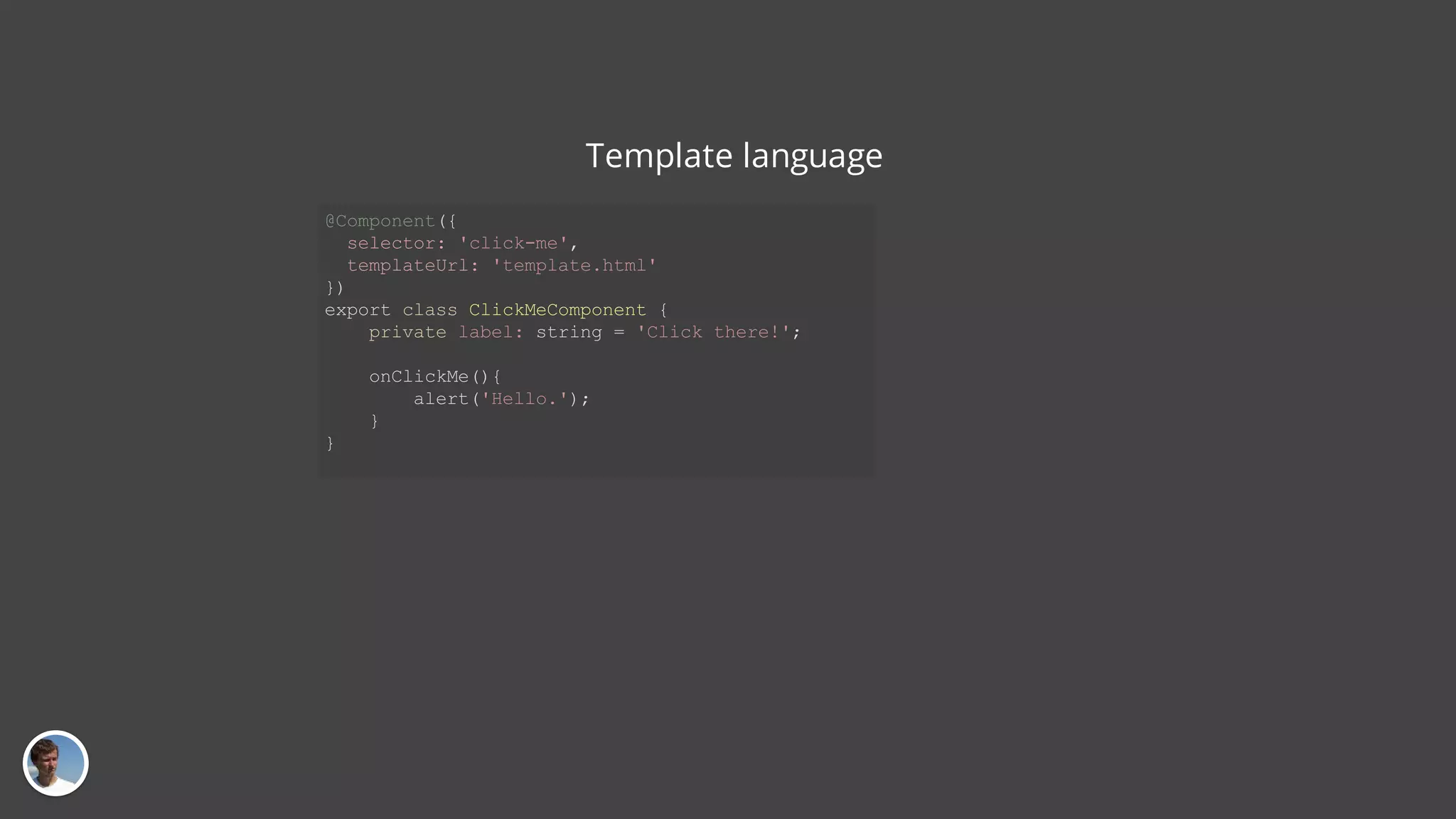
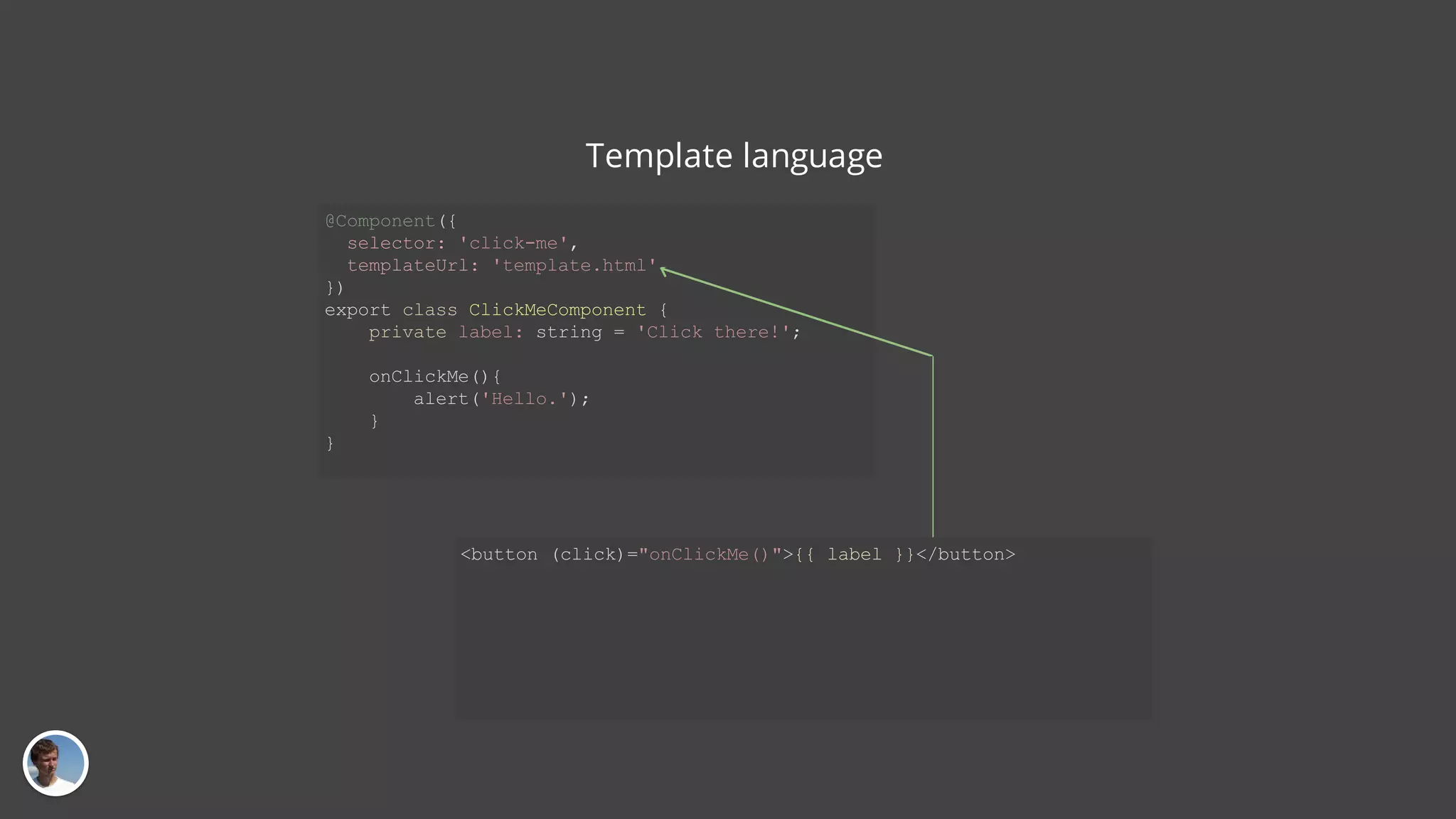
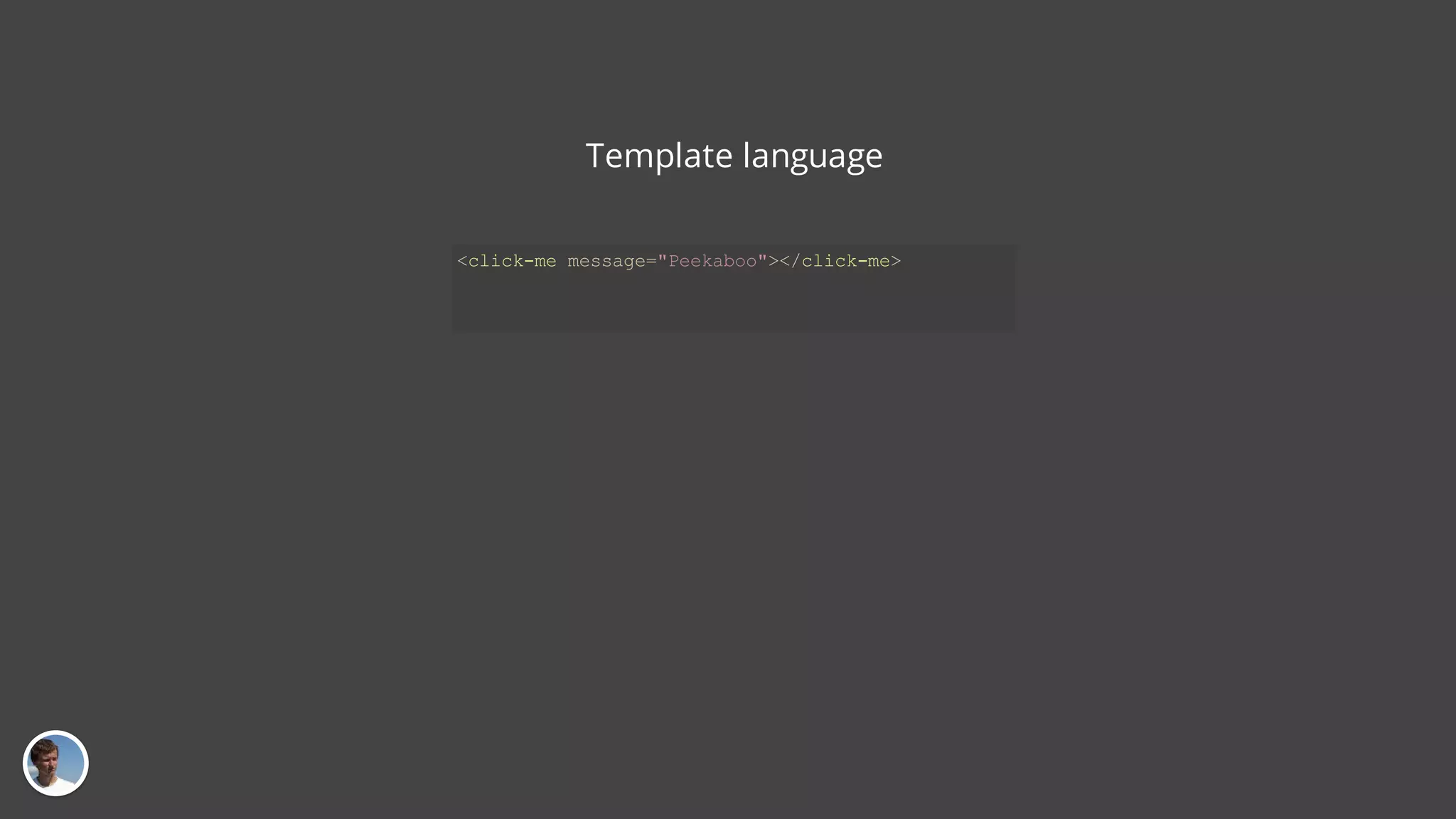
![Template language <click-me message="Peekaboo"></click-me> <click-me [message]="peekabooVariable"></click-me>](https://image.slidesharecdn.com/angular2-160212151852/75/An-introduction-to-Angular2-35-2048.jpg)
![Template language <click-me message="Peekaboo"></click-me> <click-me [message]="peekabooVariable"></click-me> <click-me [message]="peekabooVariable" (onClicked)="doSth($event)"></click-me>](https://image.slidesharecdn.com/angular2-160212151852/75/An-introduction-to-Angular2-36-2048.jpg)
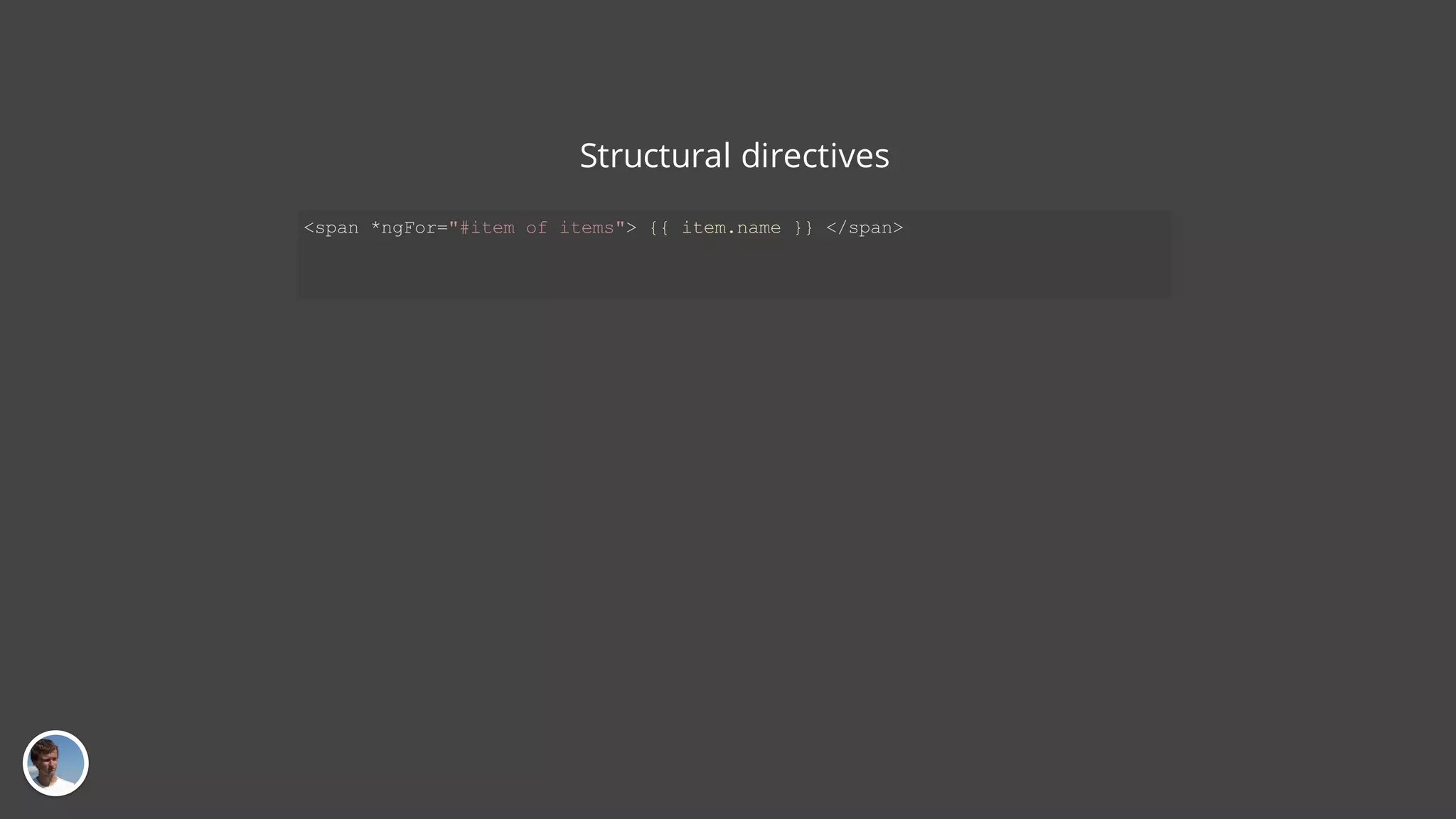
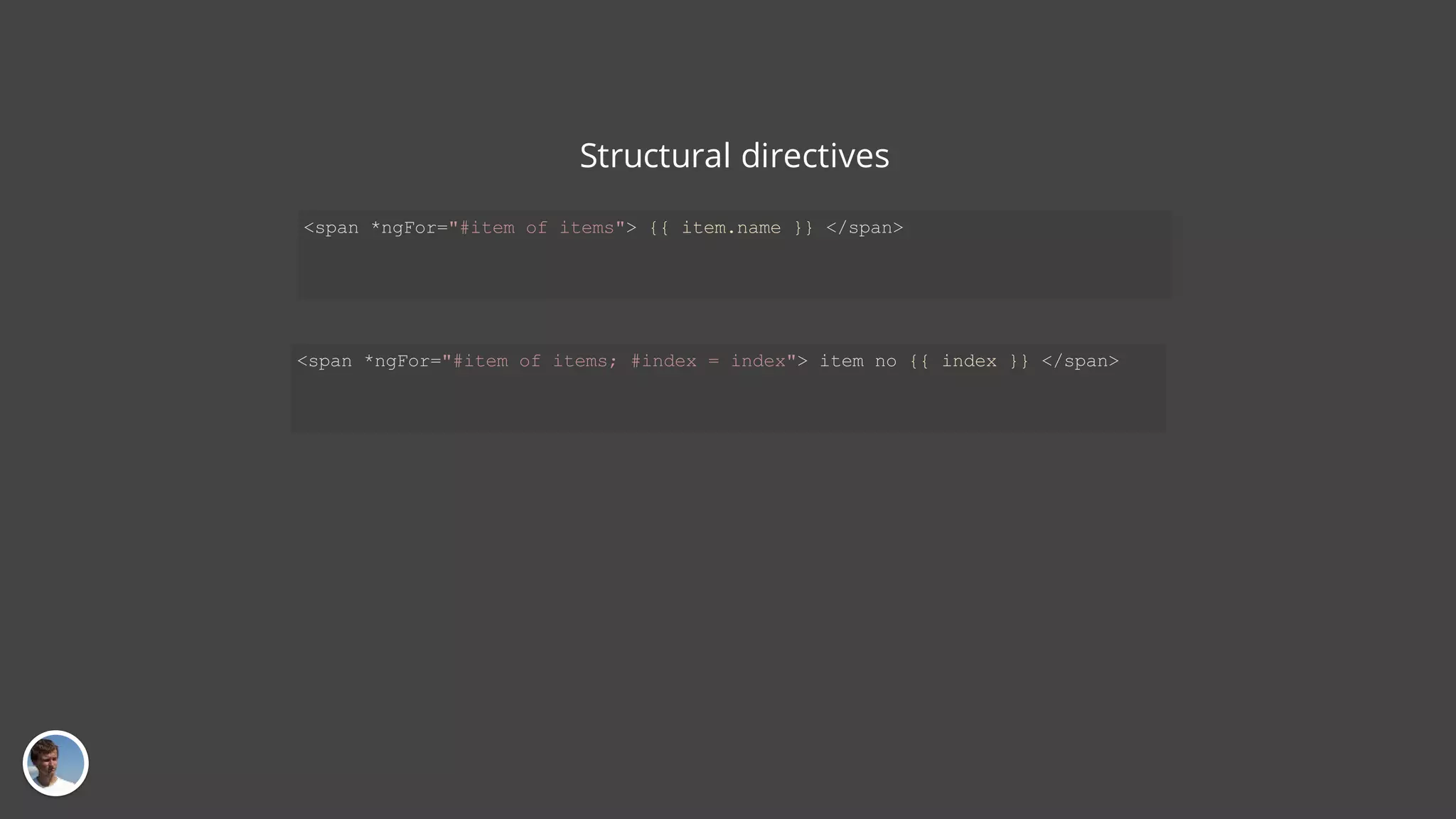
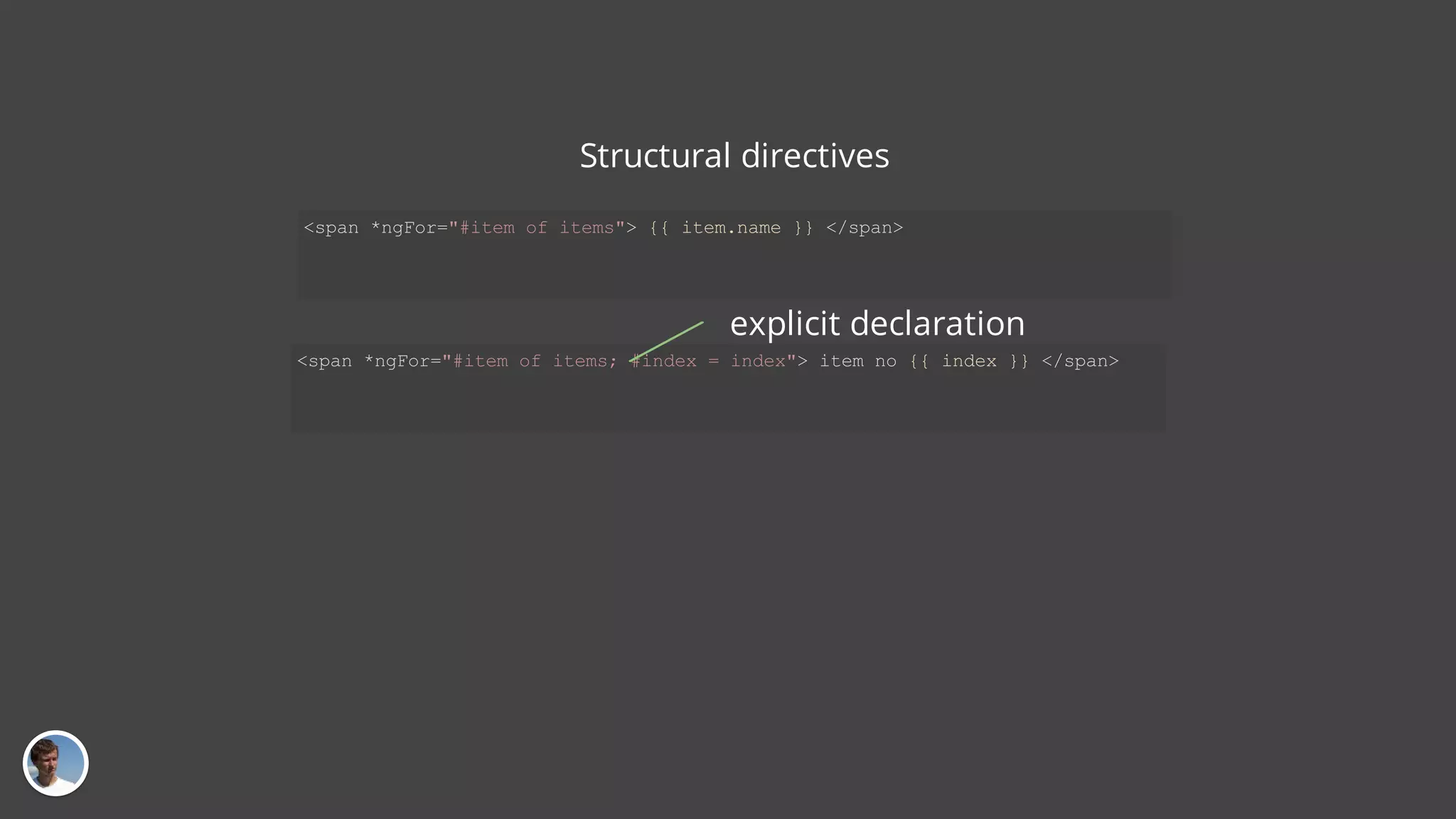
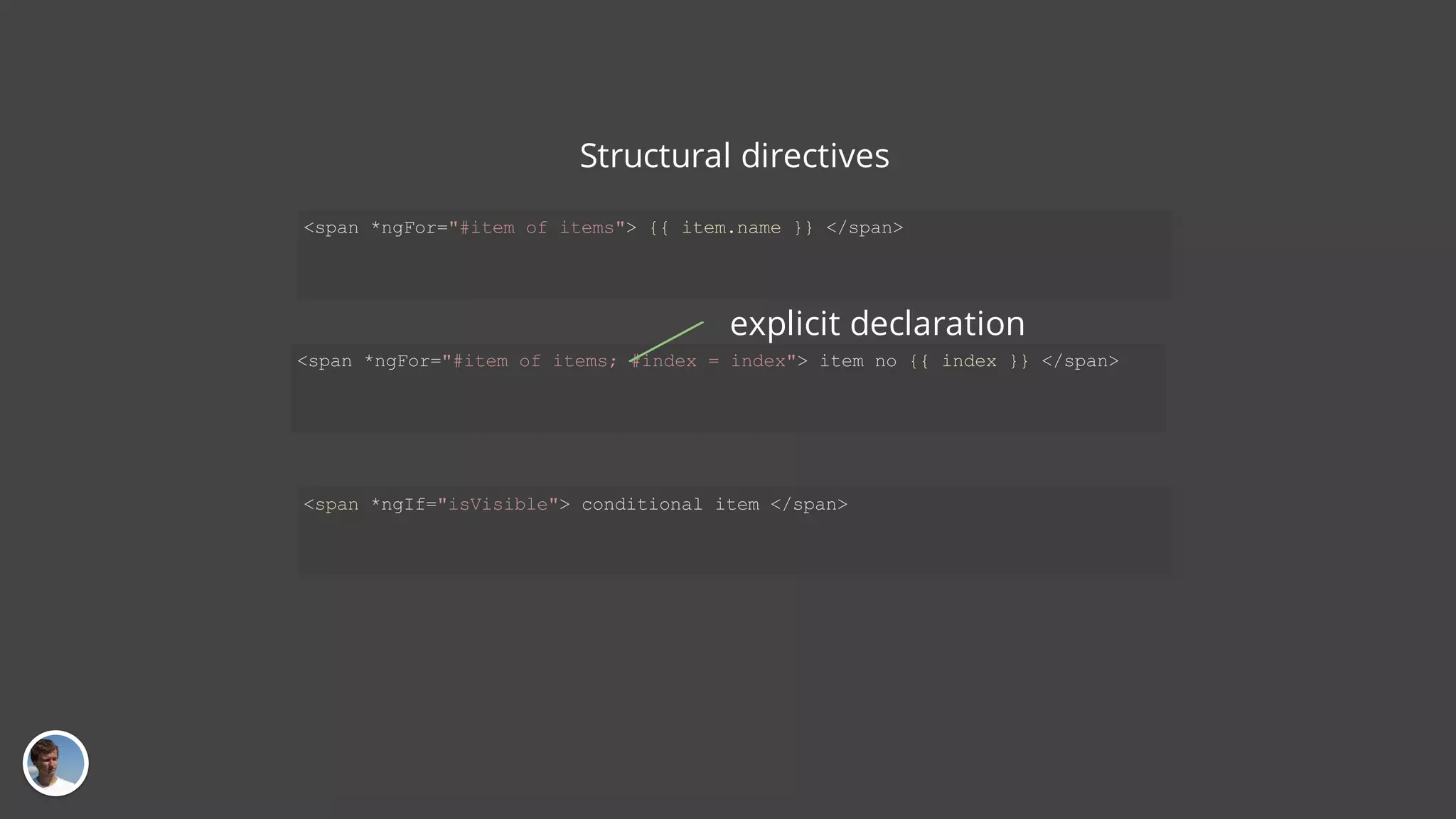
![Build-in directives <span [class.blue]="isBlue"> TEXT </span>](https://image.slidesharecdn.com/angular2-160212151852/75/An-introduction-to-Angular2-41-2048.jpg)
![Build-in directives <span [class.blue]="isBlue"> TEXT </span> <span [style.backgroundColor]="colorVariable"> TEXT </span>](https://image.slidesharecdn.com/angular2-160212151852/75/An-introduction-to-Angular2-42-2048.jpg)
![Build-in directives <span [class.blue]="isBlue"> TEXT </span> <span [style.backgroundColor]="colorVariable"> TEXT </span> <span [style.display]="isHidden ? 'none' : 'block'"> TEXT </span>](https://image.slidesharecdn.com/angular2-160212151852/75/An-introduction-to-Angular2-43-2048.jpg)
![Build-in directives <span [class.blue]="isBlue"> TEXT </span> <span [style.backgroundColor]="colorVariable"> TEXT </span> <span [hidden]="isHidden"> TEXT </span> <span [style.display]="isHidden ? 'none' : 'block'"> TEXT </span>](https://image.slidesharecdn.com/angular2-160212151852/75/An-introduction-to-Angular2-44-2048.jpg)
![Build-in directives <span [class.blue]="isBlue"> TEXT </span> <span [style.backgroundColor]="colorVariable"> TEXT </span> <span [hidden]="isHidden"> TEXT </span> <span (click)="onClick()" (mouseenter)="onMouseEnter()"> TEXT </span> <span [style.display]="isHidden ? 'none' : 'block'"> TEXT </span>](https://image.slidesharecdn.com/angular2-160212151852/75/An-introduction-to-Angular2-45-2048.jpg)
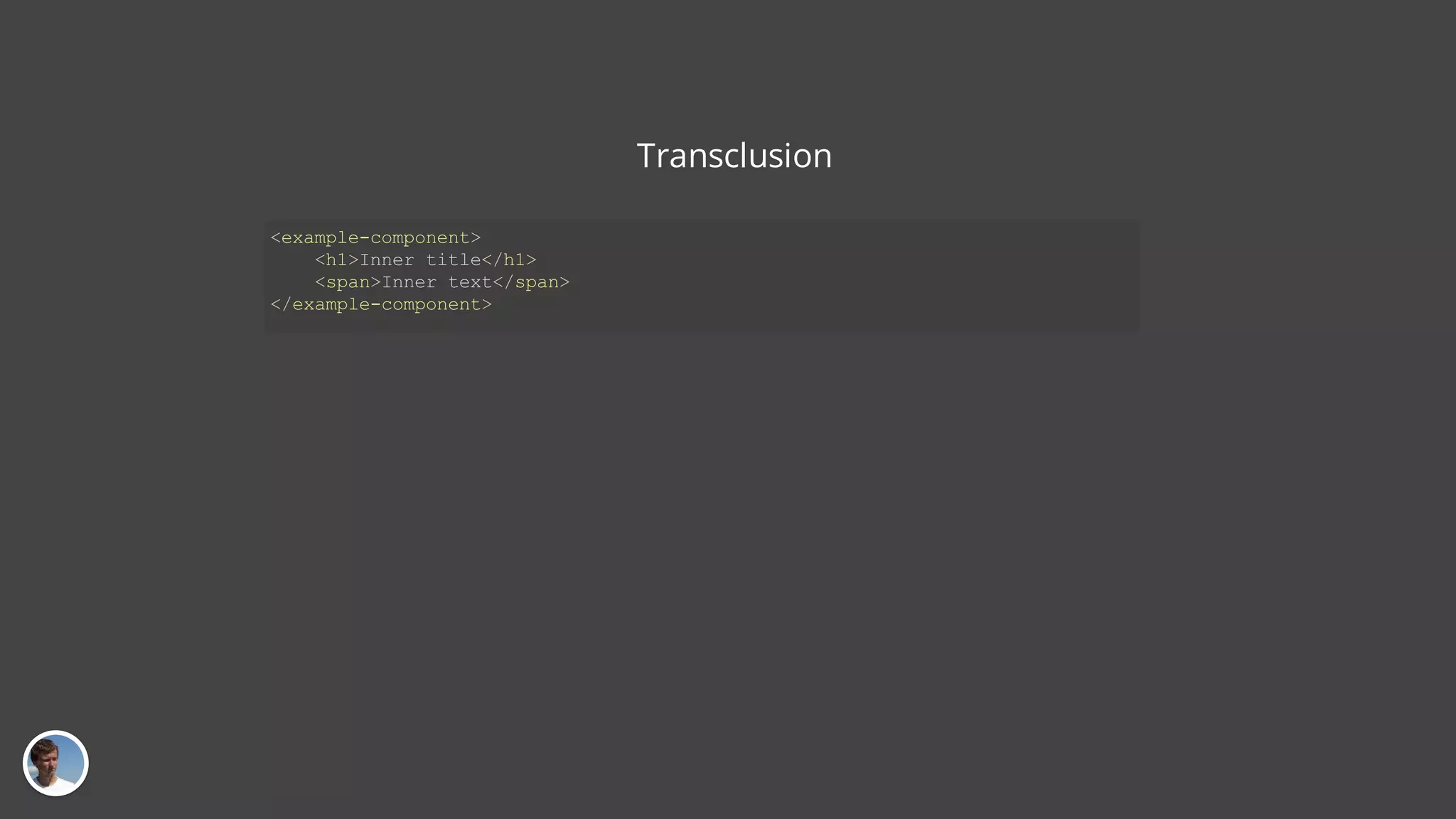
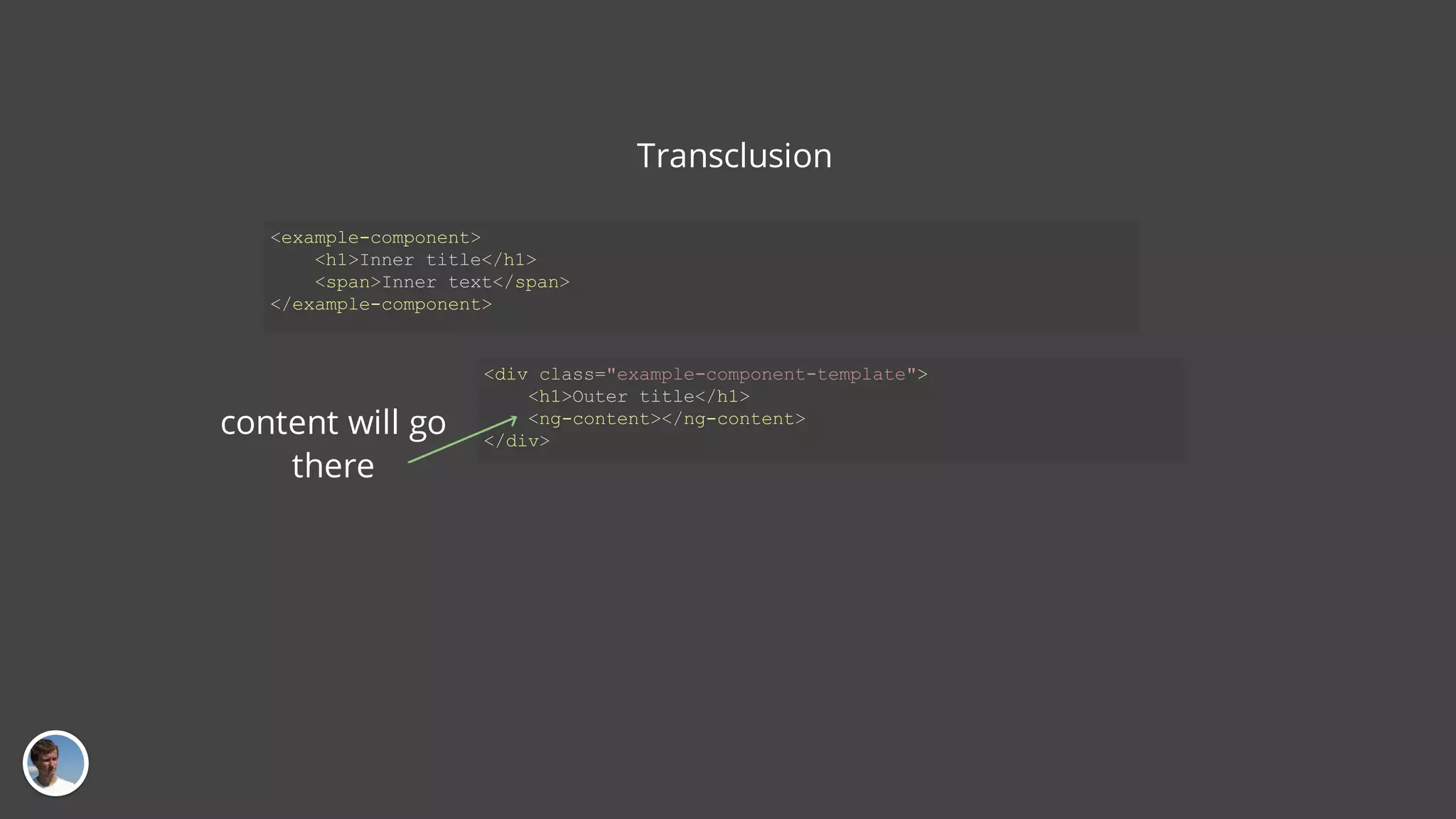
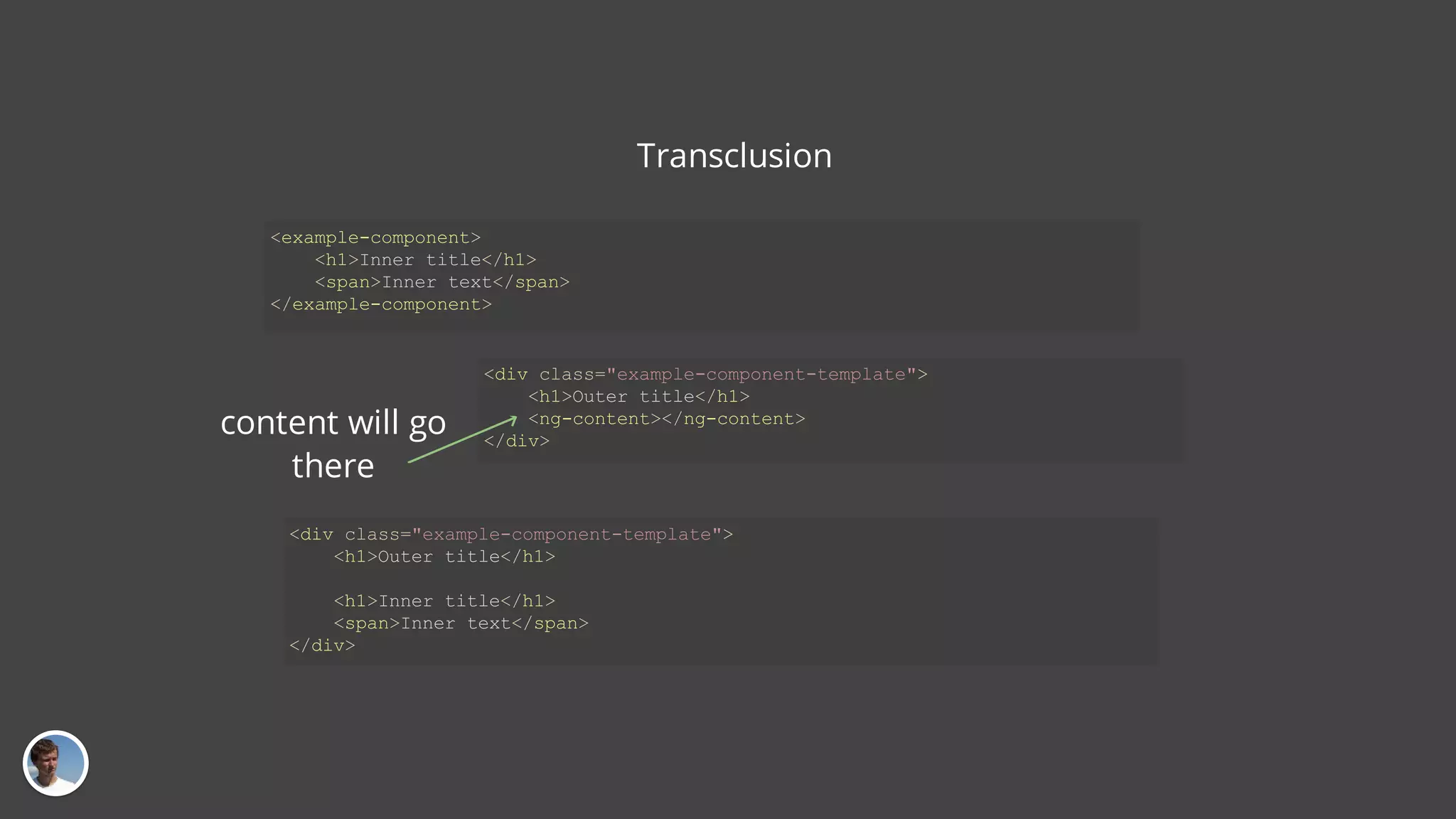
![Services class ItemsRepository { private items: Product[]; getItems(): Products[] { return this.items; } }](https://image.slidesharecdn.com/angular2-160212151852/75/An-introduction-to-Angular2-49-2048.jpg)
![class ItemsRepository { private items: Product[]; getItems(): Products[] { return this.items; } } import {ItemsRepository} from '../itemsRepo' @Component({ selector: 'click-me', templateUrl: 'template.html', providers: [ItemsRepository] }) export class ItemList { private items: Product[]; constructor(repo: ItemsRepository) { this.items = repo.getItems(); } } Dependency Injection](https://image.slidesharecdn.com/angular2-160212151852/75/An-introduction-to-Angular2-50-2048.jpg)
![class ItemsRepository { private items: Product[]; getItems(): Products[] { return this.items; } } import {ItemsRepository} from '../itemsRepo' @Component({ selector: 'click-me', templateUrl: 'template.html', providers: [ItemsRepository] }) export class ItemList { private items: Product[]; constructor(repo: ItemsRepository) { this.items = repo.getItems(); } } Dependency Injection first import](https://image.slidesharecdn.com/angular2-160212151852/75/An-introduction-to-Angular2-51-2048.jpg)
![class ItemsRepository { private items: Product[]; getItems(): Products[] { return this.items; } } import {ItemsRepository} from '../itemsRepo' @Component({ selector: 'click-me', templateUrl: 'template.html', providers: [ItemsRepository] }) export class ItemList { private items: Product[]; constructor(repo: ItemsRepository) { this.items = repo.getItems(); } } Dependency Injection first import set as provider](https://image.slidesharecdn.com/angular2-160212151852/75/An-introduction-to-Angular2-52-2048.jpg)
![class ItemsRepository { private items: Product[]; getItems(): Products[] { return this.items; } } import {ItemsRepository} from '../itemsRepo' @Component({ selector: 'click-me', templateUrl: 'template.html', providers: [ItemsRepository] }) export class ItemList { private items: Product[]; constructor(repo: ItemsRepository) { this.items = repo.getItems(); } } Dependency Injection first import set as provider inject in constructor](https://image.slidesharecdn.com/angular2-160212151852/75/An-introduction-to-Angular2-53-2048.jpg)
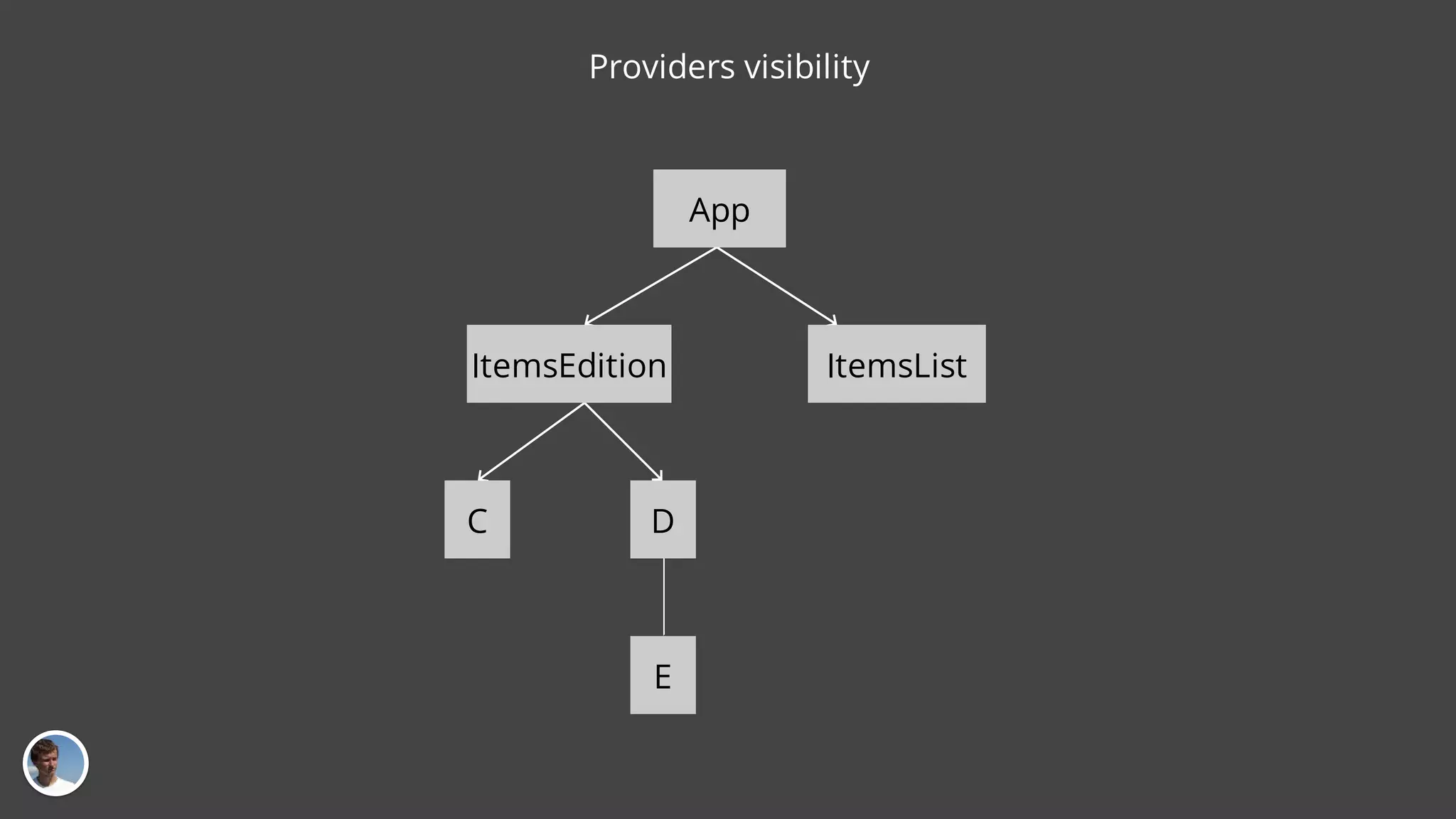
![App ItemsEdition ItemsList C D E providers: [ItemsRepository] Providers visibility](https://image.slidesharecdn.com/angular2-160212151852/75/An-introduction-to-Angular2-55-2048.jpg)
![App ItemsEdition ItemsList C D E providers: [ItemsRepository] Whole app share the same instance of ItemsRepository service Providers visibility](https://image.slidesharecdn.com/angular2-160212151852/75/An-introduction-to-Angular2-56-2048.jpg)
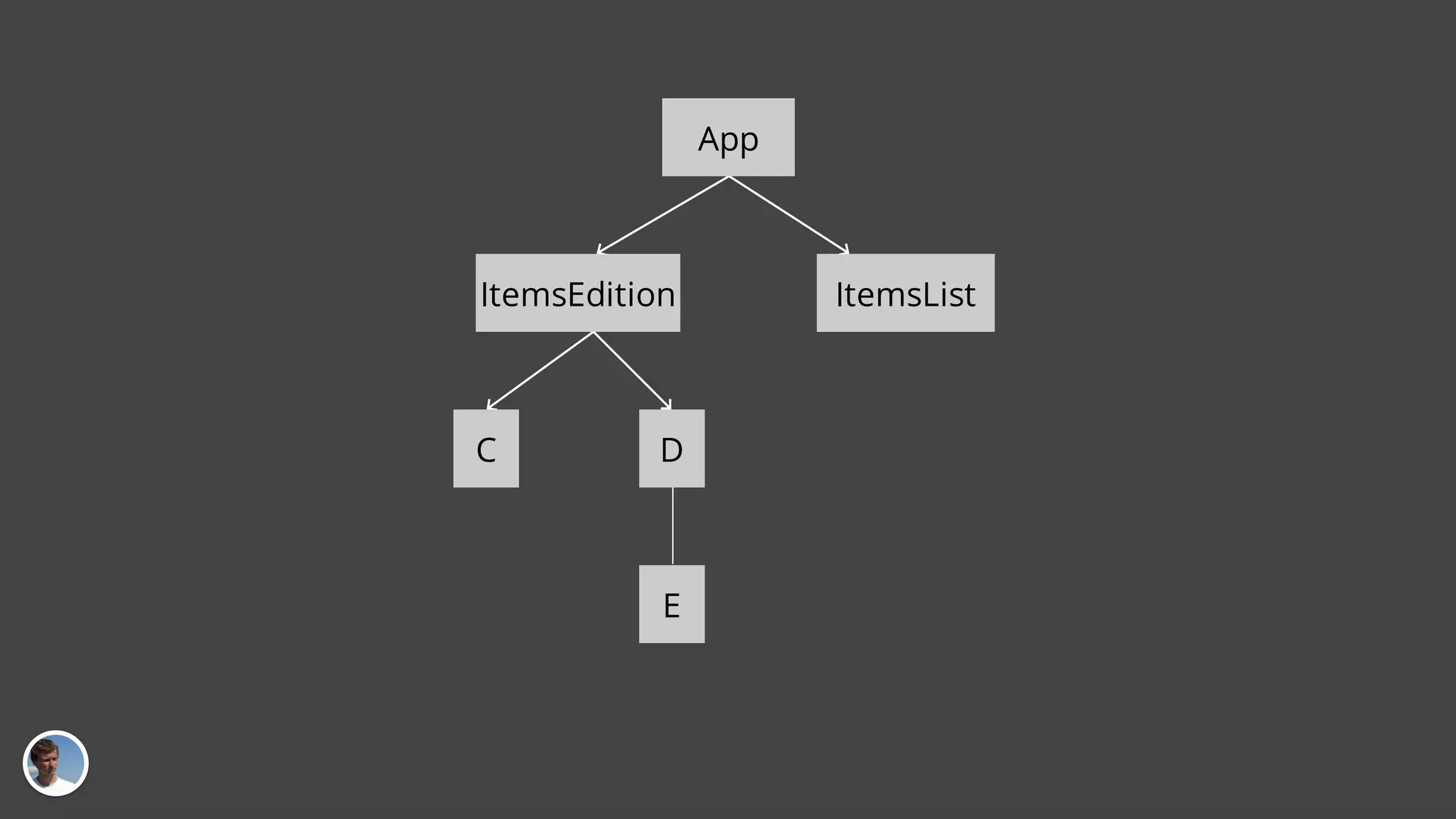
![App ItemsEdition ItemsList C D E providers: [ItemsRepository] providers: [ItemsRepository]](https://image.slidesharecdn.com/angular2-160212151852/75/An-introduction-to-Angular2-58-2048.jpg)
![App ItemsEdition ItemsList C D E providers: [ItemsRepository] providers: [ItemsRepository] Each subtree has its own instance of service.](https://image.slidesharecdn.com/angular2-160212151852/75/An-introduction-to-Angular2-59-2048.jpg)
![class Api { loadItems(): Products[] { return this.items; } } DI between services import {Api} from "./api"; @Injectable() class ItemsRepository { constructor(private api:Api) { } getItems(): Products[] { this.api.loadItems(); } }](https://image.slidesharecdn.com/angular2-160212151852/75/An-introduction-to-Angular2-60-2048.jpg)
![Mocking providers import {FakeItemsRepository} from '../fakeItemsRepo' @Component({ selector: 'click-me', templateUrl: 'template.html', providers: [ provide(ItemsRepository, {useClass: FakeItemsRepository}) ] }) export class ItemList { // ... }](https://image.slidesharecdn.com/angular2-160212151852/75/An-introduction-to-Angular2-61-2048.jpg)
![Mocking providers import {FakeItemsRepository} from '../fakeItemsRepo' @Component({ selector: 'click-me', templateUrl: 'template.html', providers: [ provide(ItemsRepository, {useClass: FakeItemsRepository}) ] }) export class ItemList { // ... } use custom provider](https://image.slidesharecdn.com/angular2-160212151852/75/An-introduction-to-Angular2-62-2048.jpg)


![Routing routes point to components @RouteConfig([ {path: '/', component: Home, as: 'Home'}, {path: '/list', component: Items, as: 'List'} ]} @Component({..}) class ...](https://image.slidesharecdn.com/angular2-160212151852/75/An-introduction-to-Angular2-65-2048.jpg)
![Routing routes point to components @RouteConfig([ {path: '/', component: Home, as: 'Home'}, {path: '/list', component: Items, as: 'List'} ]} @Component({..}) class ... <router-outlet></router-outlet>](https://image.slidesharecdn.com/angular2-160212151852/75/An-introduction-to-Angular2-66-2048.jpg)
![Routing parameters @RouteConfig([ {path: '/item/:id', component: Item, as: 'Item'} ]}](https://image.slidesharecdn.com/angular2-160212151852/75/An-introduction-to-Angular2-67-2048.jpg)
![Routing parameters @RouteConfig([ {path: '/item/:id', component: Item, as: 'Item'} ]} constructor(params:RouteParams) { let routeParamValue:string = params.get('id'); }](https://image.slidesharecdn.com/angular2-160212151852/75/An-introduction-to-Angular2-68-2048.jpg)


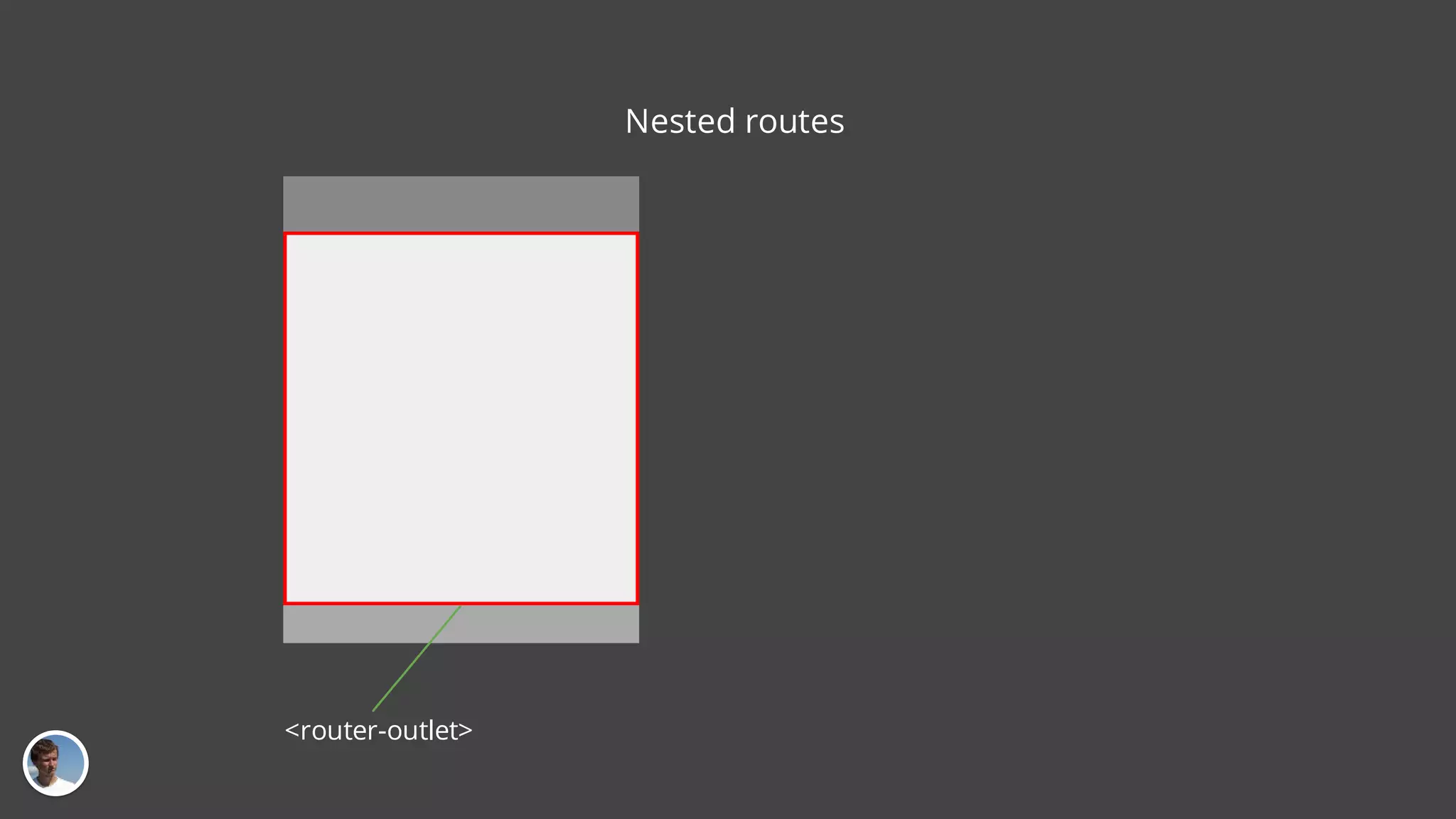
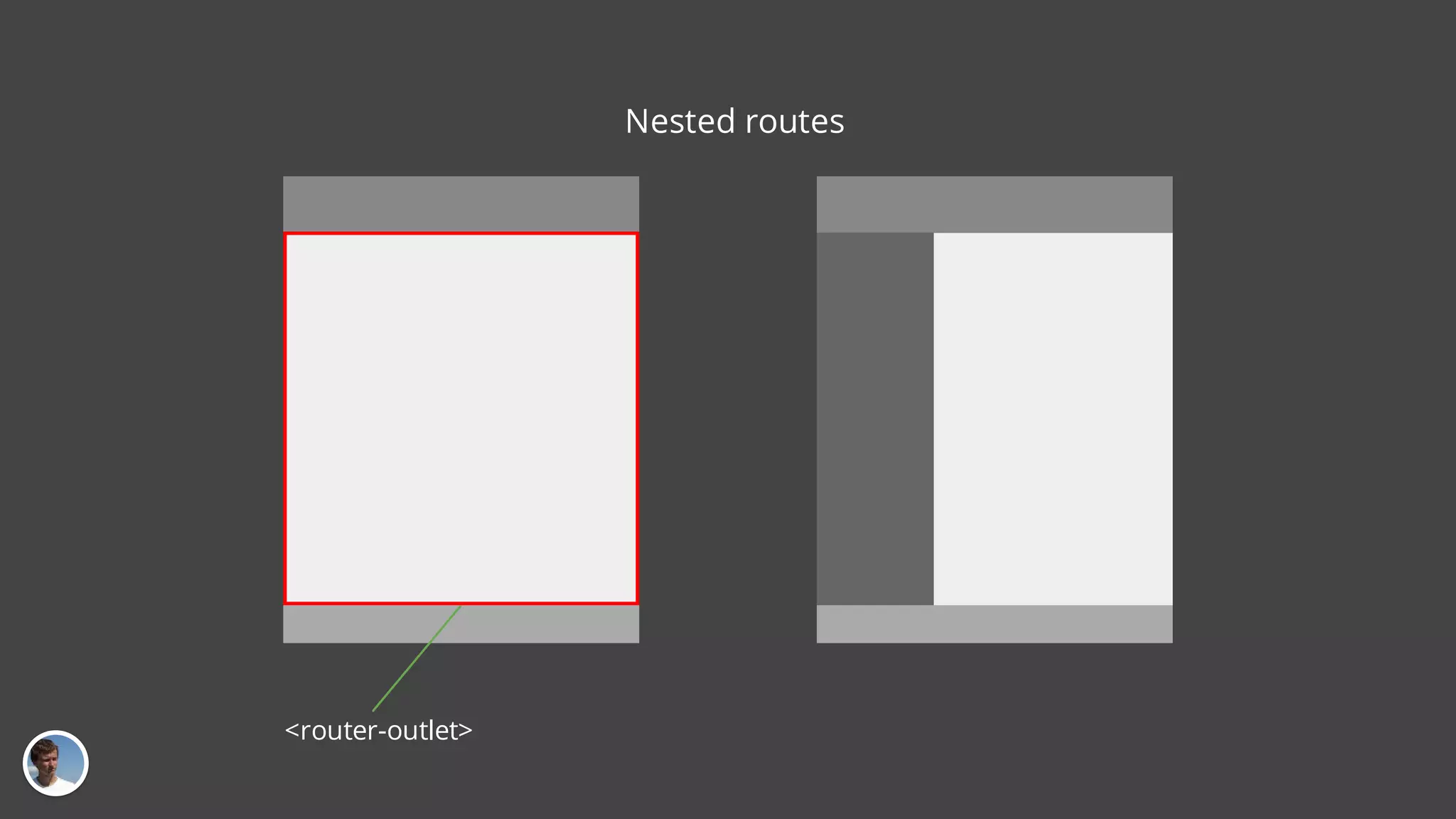
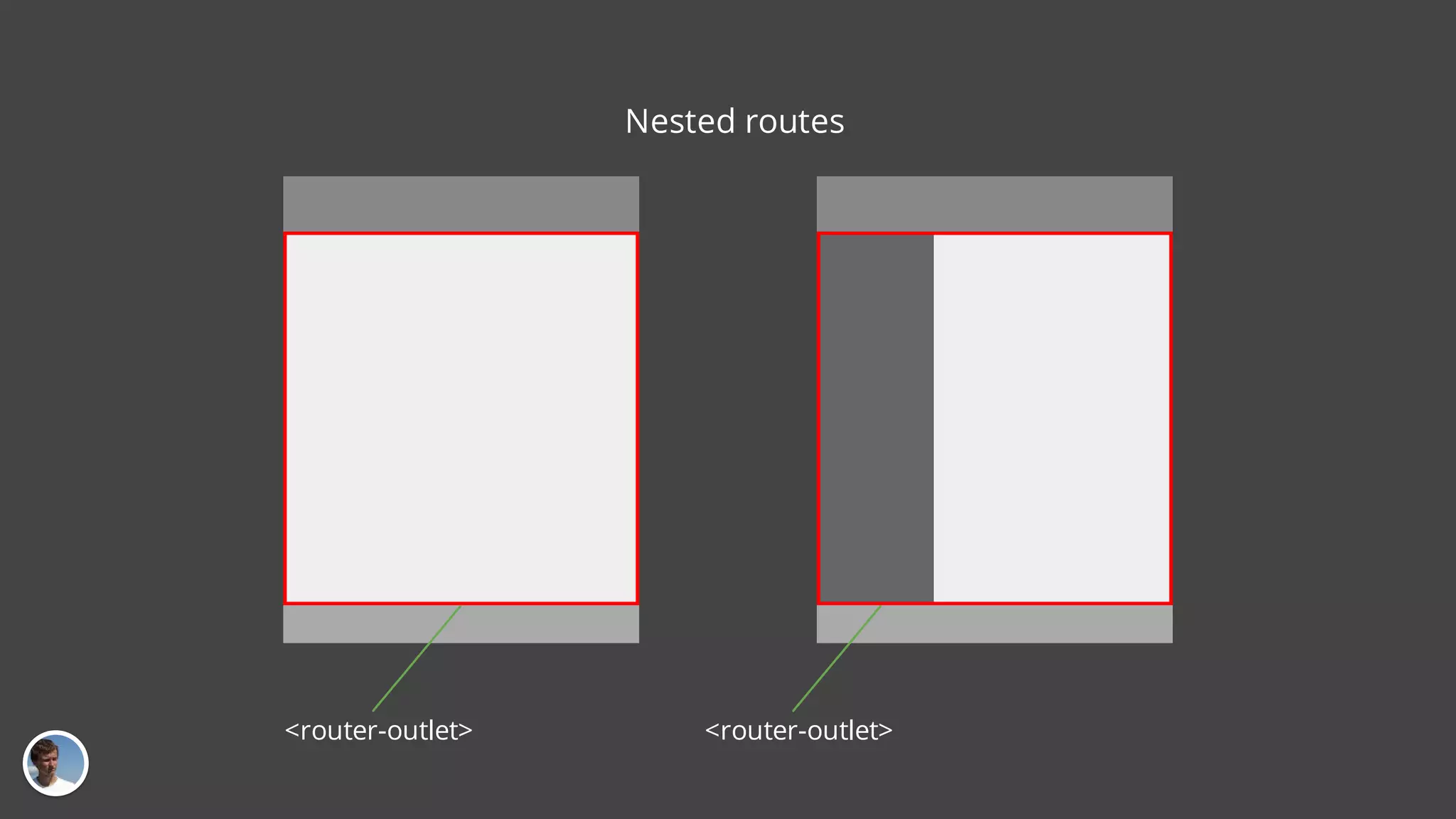
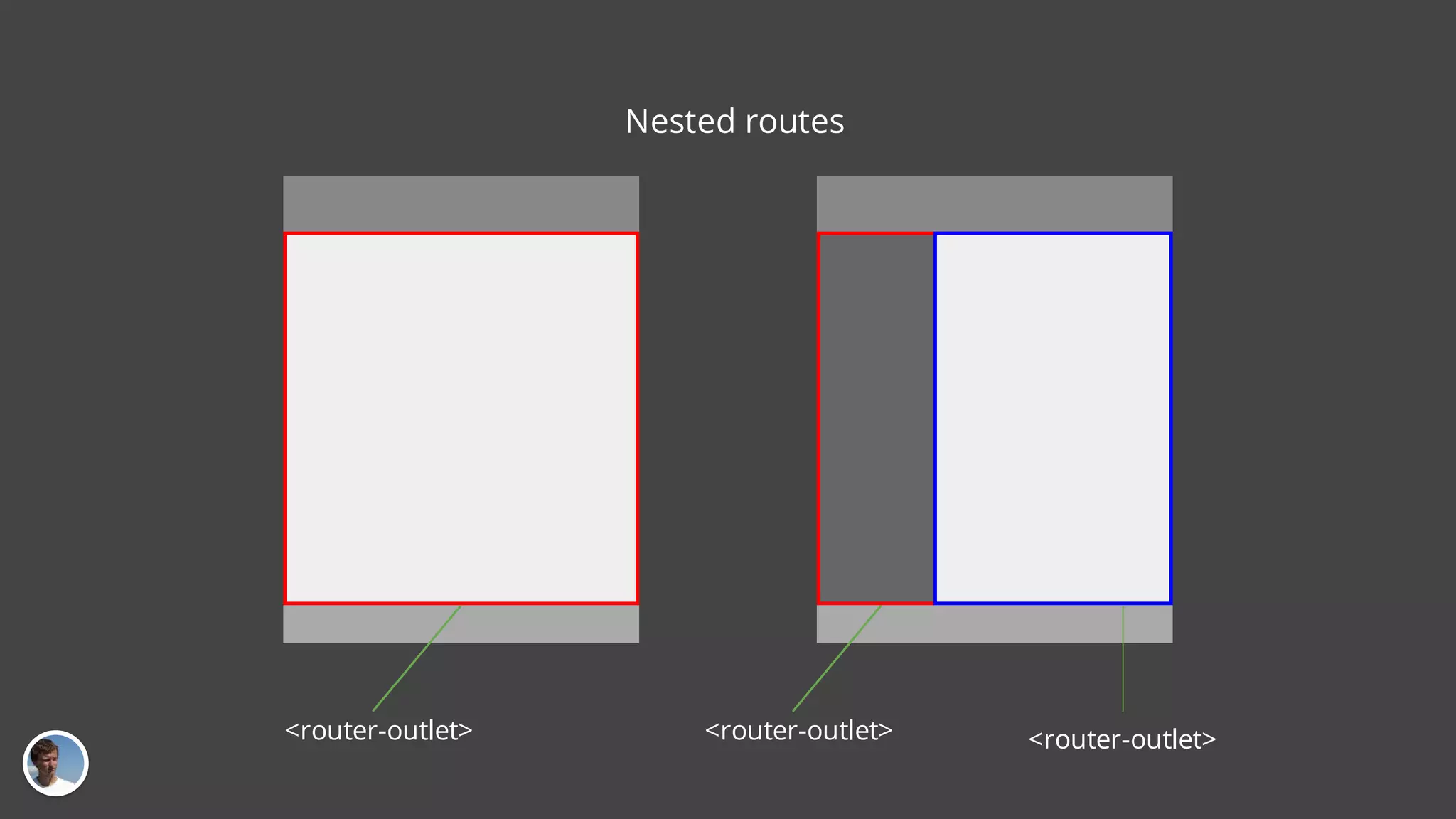
![Nested routes @RouteConfig([ {path: '/home', component: Home, as: 'Home'}, {path: '/items/...', component: Items, as: 'List'} ]} @Component({..}) class ... <router-outlet></router-outlet>](https://image.slidesharecdn.com/angular2-160212151852/75/An-introduction-to-Angular2-75-2048.jpg)
![Nested routes @RouteConfig([ {path: '/home', component: Home, as: 'Home'}, {path: '/items/...', component: Items, as: 'List'} ]} @Component({..}) class ... <router-outlet></router-outlet> @RouteConfig([ {path: '/add', component: AddItem, as: 'Add'}, {path: '/edit/:id', component: EditItem, as: 'Edit'} ]} @Component({..}) class ... <router-outlet></router-outlet>](https://image.slidesharecdn.com/angular2-160212151852/75/An-introduction-to-Angular2-76-2048.jpg)
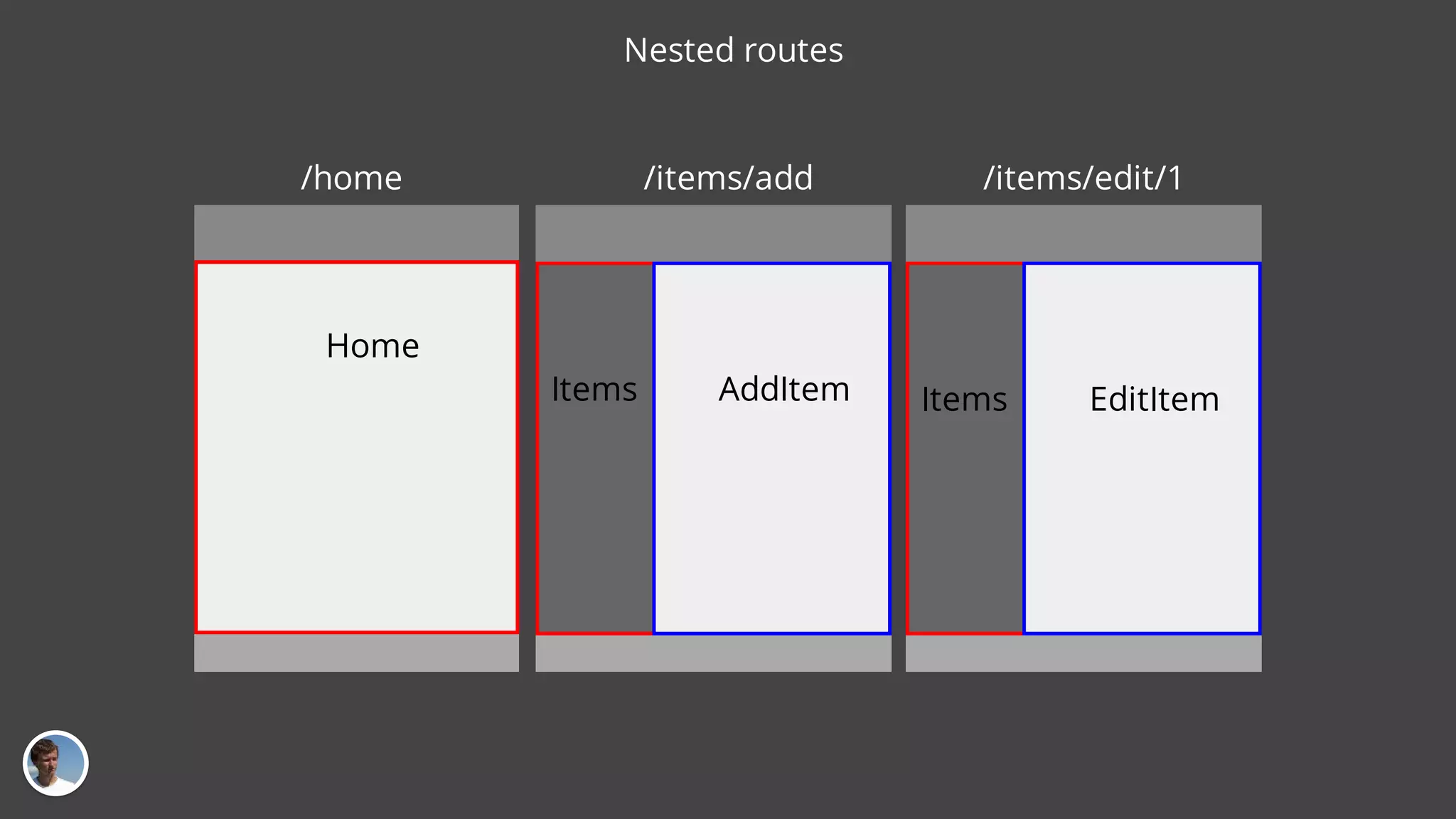
![Navigation <a [routerLink]="['Home']">Home</a>](https://image.slidesharecdn.com/angular2-160212151852/75/An-introduction-to-Angular2-78-2048.jpg)
![Navigation <a [routerLink]="['Home']">Home</a> let router:Router; router.navigate(['Home']);](https://image.slidesharecdn.com/angular2-160212151852/75/An-introduction-to-Angular2-79-2048.jpg)
![Navigation <a [routerLink]="['Home']">Home</a> let router:Router; router.navigate(['Home']); <a [routerLink]="['Items', 'Add']">Home</a>](https://image.slidesharecdn.com/angular2-160212151852/75/An-introduction-to-Angular2-80-2048.jpg)
![Navigation <a [routerLink]="['Home']">Home</a> let router:Router; router.navigate(['Home']); <a [routerLink]="['Items', 'Add']">Home</a> <a [routerLink]="['Items', 'Edit', {id: 99}]">Home</a>](https://image.slidesharecdn.com/angular2-160212151852/75/An-introduction-to-Angular2-81-2048.jpg)
![Navigation <a [routerLink]="['Home']">Home</a> let router:Router; router.navigate(['Home']); <a [routerLink]="['Items', 'Add']">Home</a> <a [routerLink]="['Items', 'Edit', {id: 99}]">Home</a> <a [routerLink]="['Item', {id:99}, 'Edit']">Home</a> /item/:id/edit](https://image.slidesharecdn.com/angular2-160212151852/75/An-introduction-to-Angular2-82-2048.jpg)

